1lumen selects and reviews products personally. We may earn affiliate commissions through our links, which help support our testing.
Nitecore MH40S review: throw flashlight test
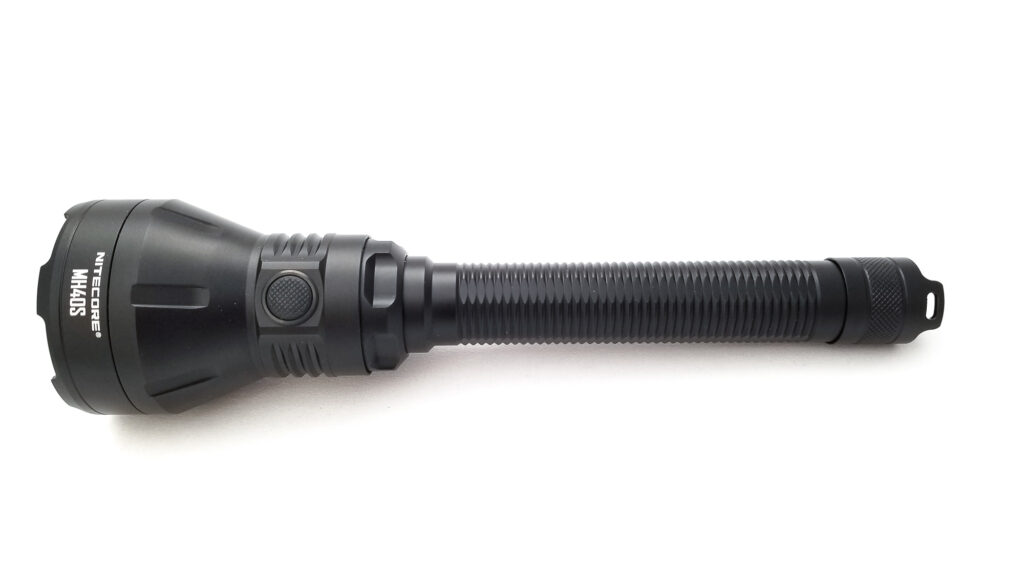
Nitecore MH40S specifications
| Brand & Model | Nitecore MH40S |
|---|---|
| LED | Luminengin G9 |
| Lumens | 1,500 Lumens |
| Beam intensity | 570,000 cd |
| Battery config. | 2*21700 |
| Onboard charging | USB-C |
| Modes | 4 |
| Blinkies | Strobe, SOS, Beacon |
| Reflector | Smooth |
| Waterproof | IP68 |
| Review publication date | August 2022 |
Introduction:
Nitecore (officially the SysMax Innovations Co. Ltd.) has been in the flashlight business a long time (15 years). Like Fenix and Olight, Nitecore has eked out a pretty comfortable position in the consumer and enthusiast flashlight market, and they have a product continuity that keeps both camps interested and attentive. One way they do this is with continual product improvement, and this is something all the big names in portable illumination do. It’s good for everyone because the end result are products that keep getting better and better over time.
Take the MH40 series. Introduced in 2013 as a 2×18650 single emitter tactical-use flashlight, the first MH40 aka Thor, featured a then-new XM-L2, 1000 Lumens, and an impressive 64,000 cd, and it was rechargeable! The MH40 was followed by the successor MH40GTR in late 2017 with a Cree XP-L emitter which gave a huge bump in throw and a bit more output. Everything else was the same though, down to the barrel jack charge port. Fast-forward to 2022 and there’s a new MH40, the S model. The S model catapults the MH into the 21st century with features a modern LED, USB type C quick charging, and a trick up its sleeve you don’t normally see on lights like this. It retains the familiar features of the GTR, with tasteful, modern conveniences to augment usefulness and performance. Nitecore sent one out to test on, so let’s see!
Package quality.
Like any mainstream brand, you get a really nice package. In fact, Nitecore products can be found in some brick and mortar shops, so they need eye-catching graphics and tons of features and specs. The MH40S package doesn’t disappoint. Inside the light is nestled in foam, with the accessories neatly stowed in boxes. The charging adapter had its own box, and the holster and other bits were in a bigger box. It’s very Olight-esque and I really like that. For accessories, you also get everything but the kitchen sink in there:
- Nitecore MH40S
- 2 Nitecore NL2150 5000 mAh 21700 (in the light)
- Spare o-ring
- Lanyard
- Manual
- Holster
- 2 short sections of Picatinny rail mounts
- USB type C cable
- 18 W USB type C charger
- 2 hook and loop straps
- 1 hook and loop fastener
- Wireless remote control (with battery)
I really like to see this from mainstream brands, and it’s important for non-enthusiast users who don’t have chargers, batteries, etc. Everything is included (and then some) to get up and running. It’s an impressive amount of kit for sure, and all the accessories seem very high quality. The charging adapter is ETL certified (independent safety testing lab), so it’s not some generic cheap charger. Very impressive. I like the Nitecore logo on the hook and loop straps also. Strangely, there’s no logo on the holster though.
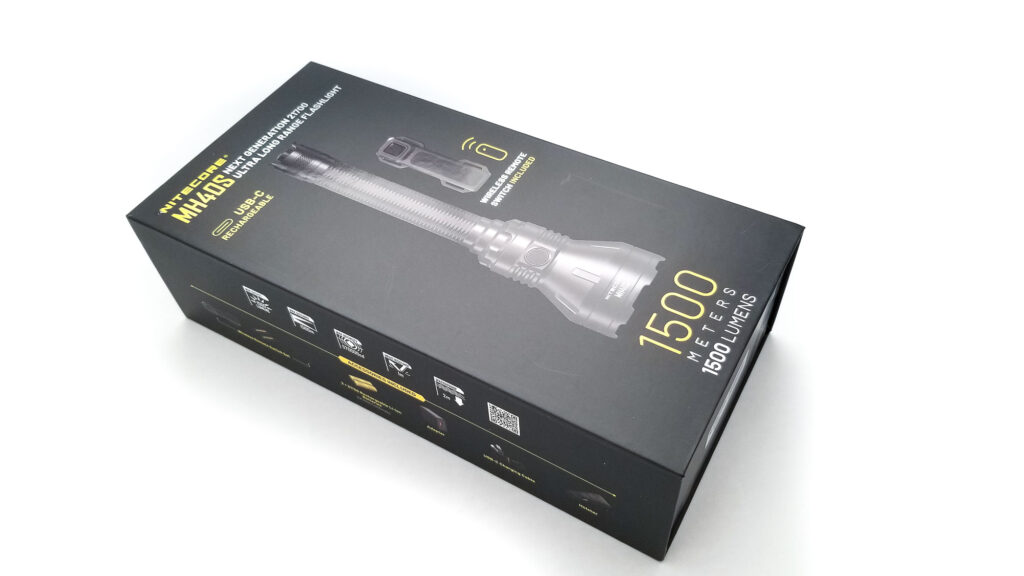
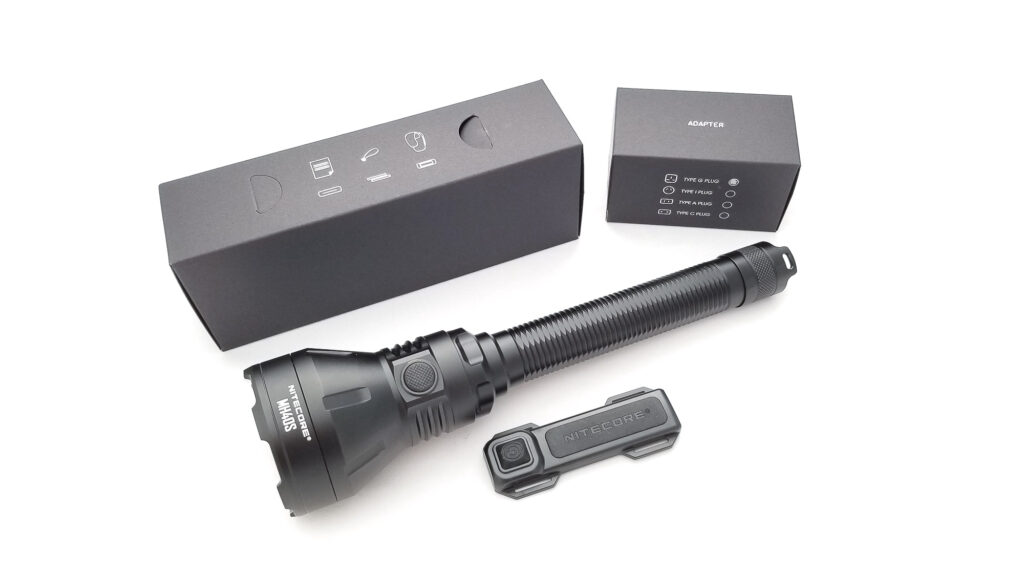
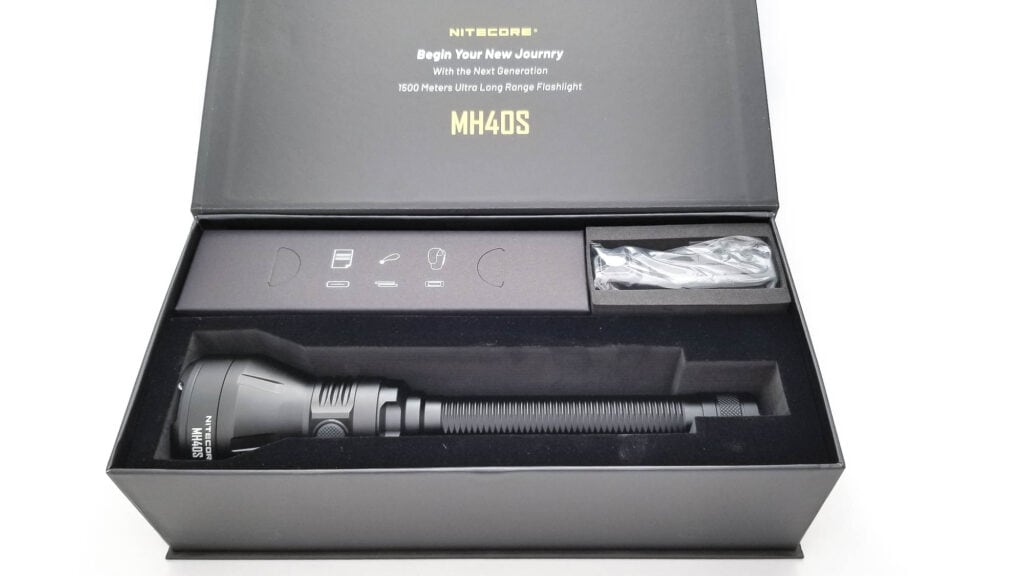
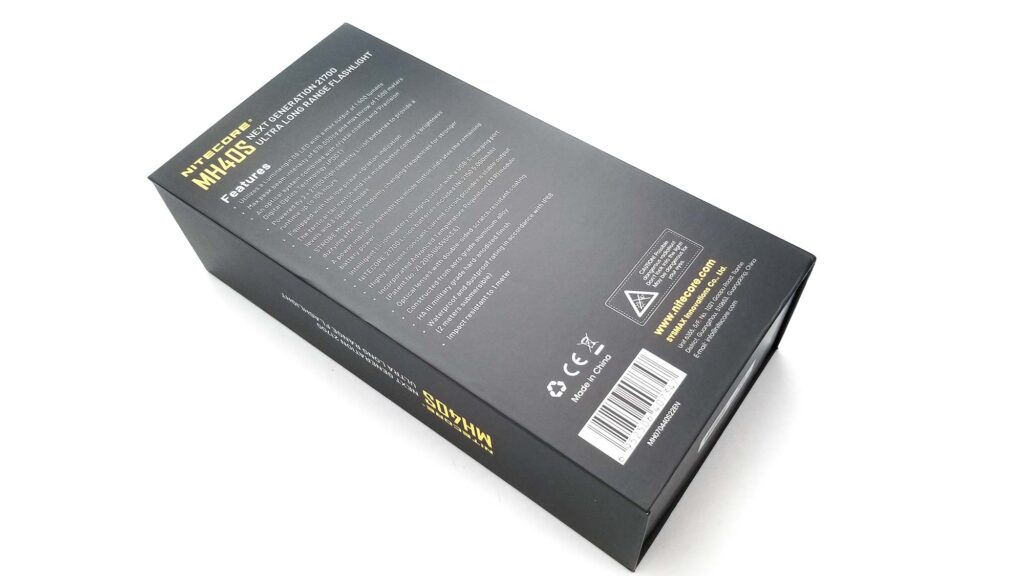
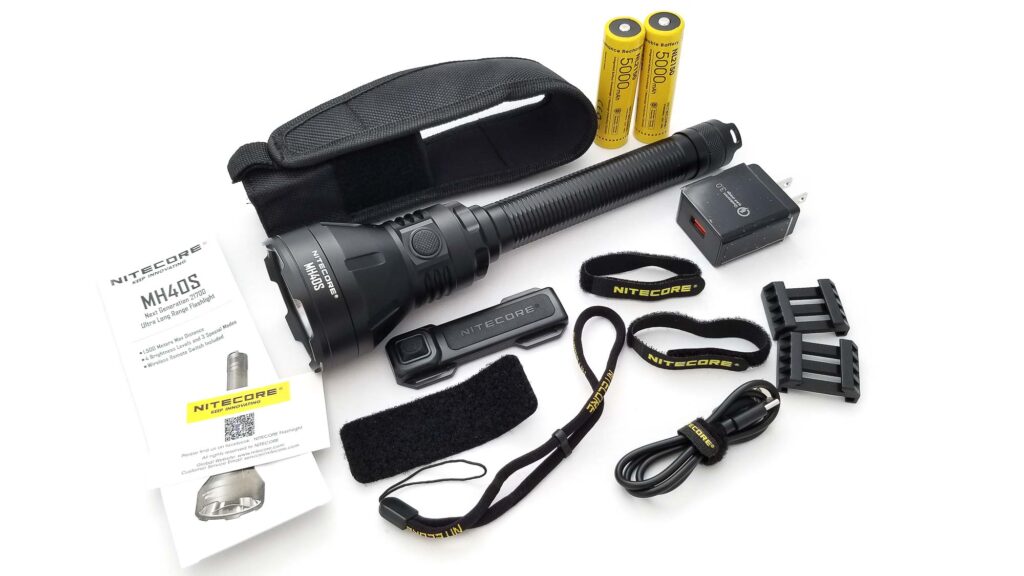
Flashlight in use
The Nitecore MH40S is a long-range multipurpose light, also known as a thrower, and there’s a lot you can do with one of these, but the short list is long-range searching, hunting (Nitecore sells mounts for the light and mounts are included for the remote), observing, or inspecting. It could also be used as a duty light for law enforcement, first responders, or security personnel who need a long throw duty light. For non-professional users, the MH40S is too big and impractical to be a carry or EDC light, but it would happily be a dedicated long-range spotlight for those times when you don’t need 3,000 or even 5,000 Lumens. It would be a great companion to holster up and take on a night walk or hike.
Handling is about what you expect from a long dual-21700 light. It’s nicely balanced and the tube diameter is perfect for most all hand sizes and grip positions (saber or ice pick). The texturing on the battery tube is very grippy and ensures good control with wet/sweaty or gloved hands. Although using a long light like this one-handed is a bit of a gymnastics exercise, it’s made easier by the addition of an e-switch behind the head, but for mode changes, you’re going to have to shift your grip and use two hands. There’s still a rear forward clicky at the tail for on/off and momentary use, and you must turn the light on with the rear switch. The e-switch cannot turn the light on or off. The original MH40 and GTR had to make do with a rear clicky and a weird twist-action for mode changes, so it’s nice to see a more normal configuration this go around. The switches feel good, with snappy clicks at the rear and nice feedback from the side switch. The side switch is easy to find by feel, and it has blue LED indicators under the boot for battery status as well.
There’s a single USB type C charging interface opposite the switch, and it’s sealed with a very nice flush-fit rubber boot that didn’t snag or hang on things and open inadvertently. For retention, Nitecore eliminated the pocket clip found on the first two MH40 lights, but retained the dual lanyard holes at the tail, which has big enough openings to allow easy mounting of the lanyard. There’s also a nice belt holster (bezel up only) with a sturdy D-ring for clipping to a carabiner and mounting to your pack, turnouts, MOLLE or battle rattle.
However, the showpiece of this light is the remote. Yep, you heard that right, the MH40S is the second commercial light to feature a wireless remote control. The Wuben A1 was first (but that light cost $1000), so it’s nice to see it in a more available/affordable flashlight. Instead of Bluetooth, this one runs on standard 2.4 Ghz radio signal band, and unfortunately that limits the range a bit to 1 meter (versus 10 for the A1), but that’s plenty because the main objective was wireless remote switching for WML applications. The wireless switch has two buttons, a large contact pad aft for momentary Turbo, and a smaller button at the front for on/off and mode switching. These switches have a nice click action, and the front switch behaves a bit like a mechanical clicky, with a dual-position action (more on that in the UI section).
Nitecore includes a generous hook-and-loop pad and 2 hook-and-loop straps for affixing the switch to your firearm, or if you’ve got a M1913 Picatinny rail (handguard, receiver, etc.) you can use the included 2 short sections of Picatinny rail mounts. The actual mount for the light is sold separately, and Nitecore sells one for just about every mounting configuration. Tail standing is a no-go this time, but the MH40S has anti-roll cuts in the head to keep it from rolling over, Rover.
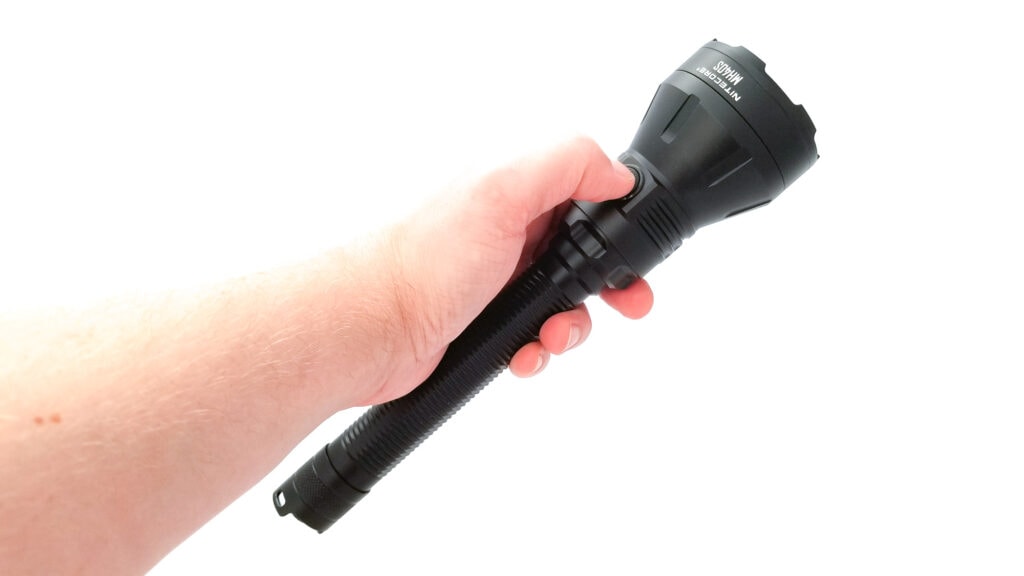
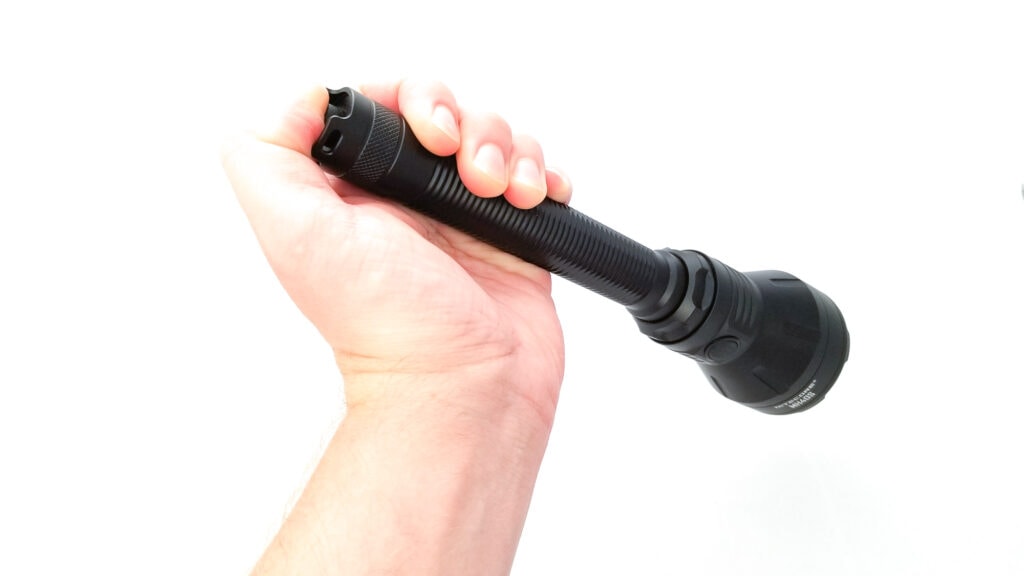
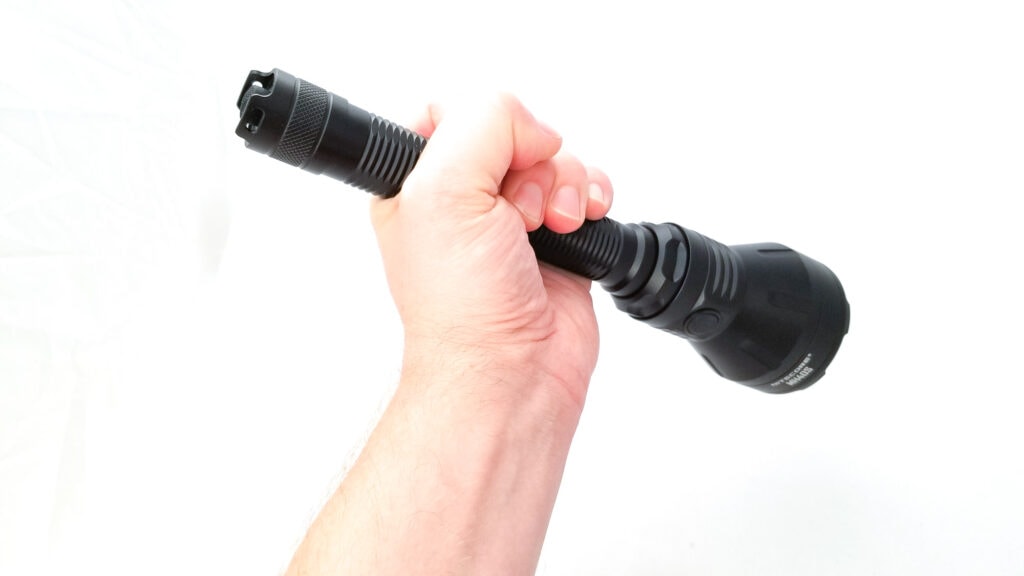
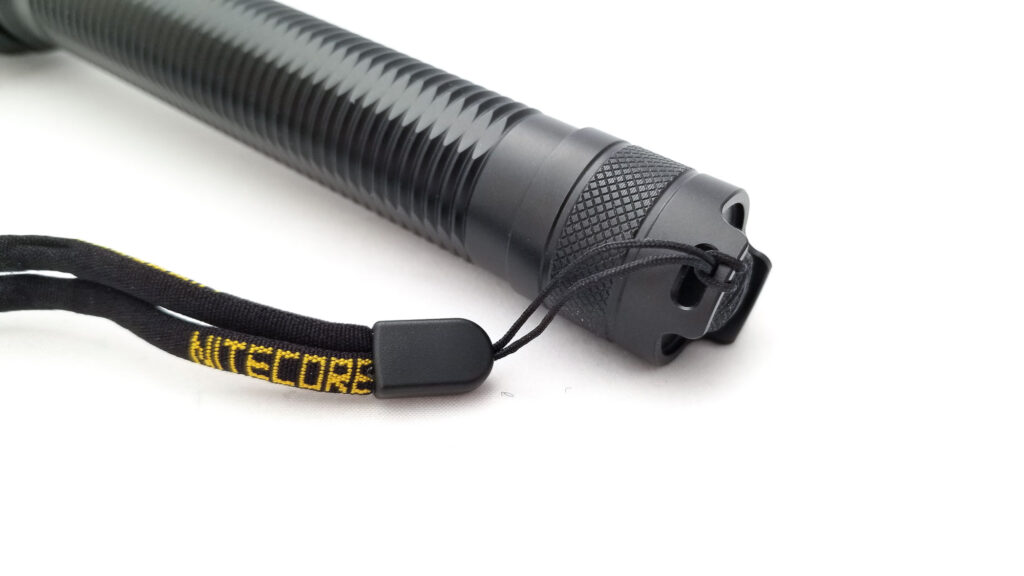
Build Quality, and Warranty
Nitecore makes nice lights, and they fall somewhere in between Fenix and Olight and Acebeam price-wise. The MH40S retails for about $200 US, and that’s not a bad deal for everything you get (the two batteries alone are $22 each sold separately). Overall I’m very impressed with the build quality. It just feels premium with great fit and finish, and the machining is very nicely done. The light is made from aircraft aluminum, and the machining is extremely tidy; no machine marks, flashing, burrs, nada. The silkscreening and laser-etching is very well done, and the text is sharp and easy to read. Every surface has been blended and chamfered for smooth, snag-free holstering and unholstering. The finish is type III HA anodizing, and it seems to be very good quality and durable. I didn’t see any issues with coverage, blemishes, or color variations. It is a bit glossy for my liking though, and I prefer a more matte finish on these working lights. The batteries did rattle quite a bit in the tube when shaken.
In true tactical-use form, Nitecore uses springs at both ends of the tube: The tail spring is gold-plated and decently-sized, and the back of the driver seems to have a spring-loaded plastic pad with a gold contact point for the battery positive. These are just about mandatory for hard-use lights that can mount to a rifle. They provide shock absorption from drops or bangs, and absorb recoil impulses. This protects the light and ensures the batteries don’t rebound and cause connection breaks. The rear spring isn’t particularly thick, but they don’t need to be since the light draws less than 10 amps. The light cannot be disassembled (glued up), and only the tailcap is removable.
The rear threads are fully anodized, generously sturdy triangular cut deals with plenty of lube and are very smooth. I did have to press down a bit to get the tailcap seated before the threads engaged, which might cause cross-threading if you aren’t careful. The charge port cover has a generous rubber seal, and there’s a single o-ring sealing the rear. These lights have to work in all weather conditions, and Nitecore properly rates the MH40S at IP68. It’s impervious to dust and sand, and good for 2 meters of temporary immersion.
Nitecore has one of the best warranties in the industry: 15-day no hassle coverage for defective or DOA (dead on arrival) products, followed by a limited lifetime warranty. Depending on the product, it’s good for up to 60-months (lights with internal batteries get a 24 month warranty, NPS, NB series get a 18 month warranty). The warranty covers defects or malfunctions not caused by neglect, abuse, or intentional damage. After the warranty period, Nitecore will repair or maintain covered products (parts or accessories are not covered). NL batteries are warrantied for 12 months, all other batteries for 3 months. Holsters and lanyards are warrantied for 24 months.
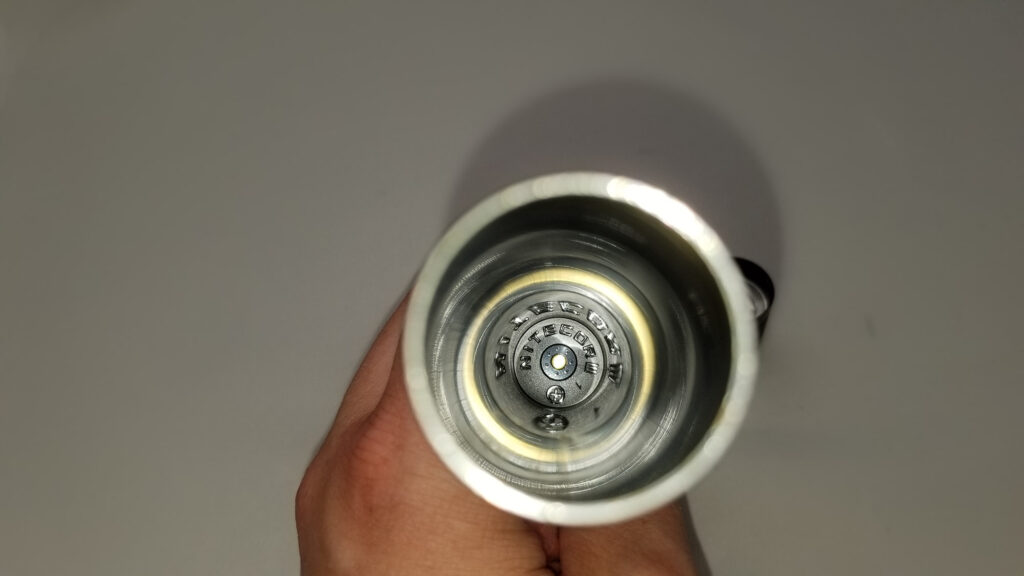
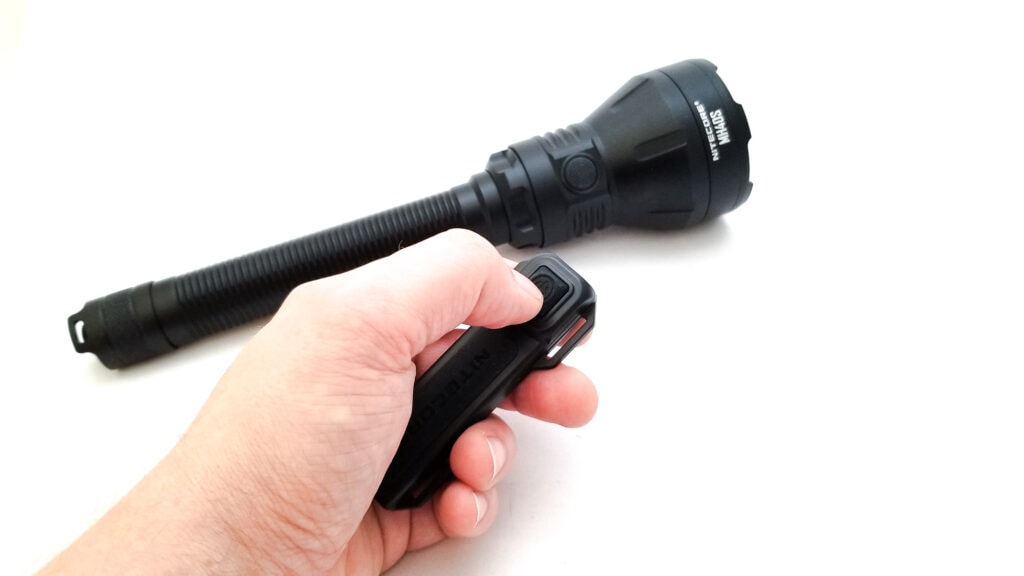

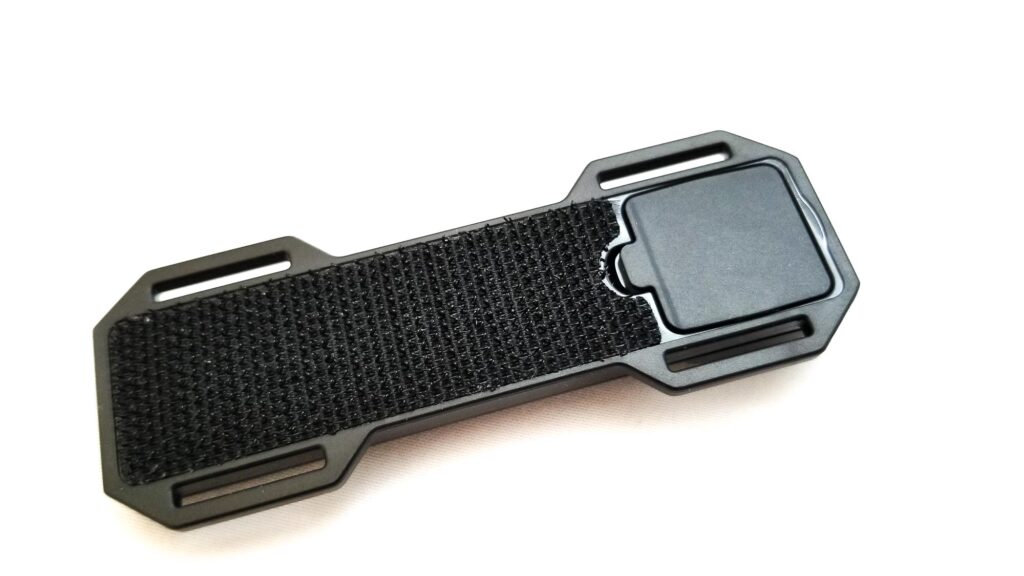
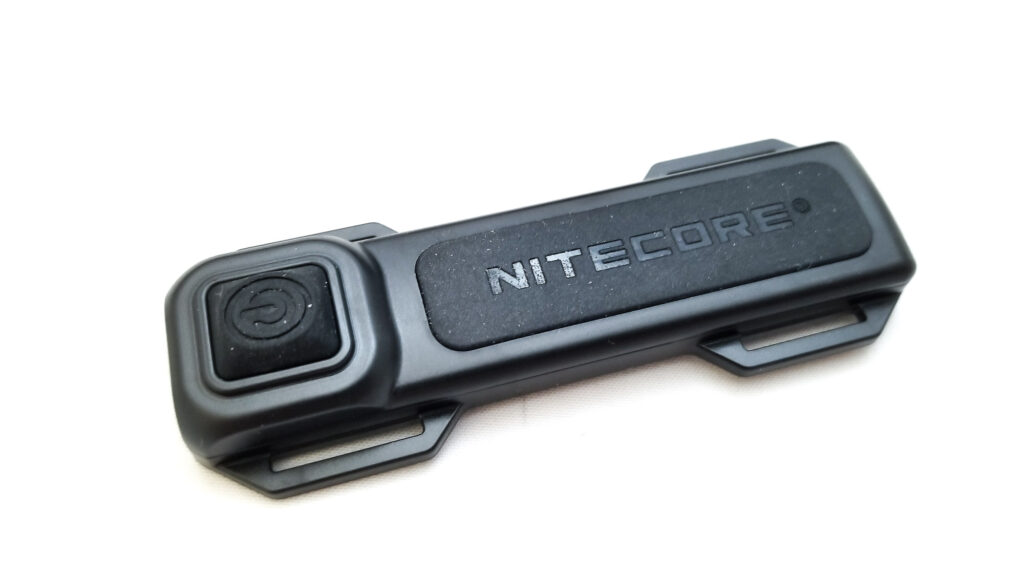

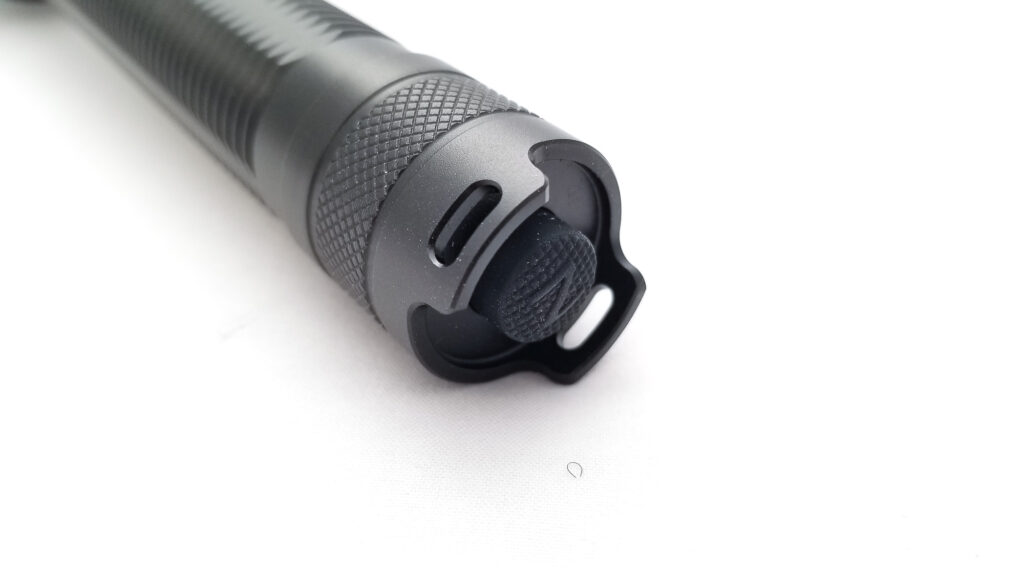
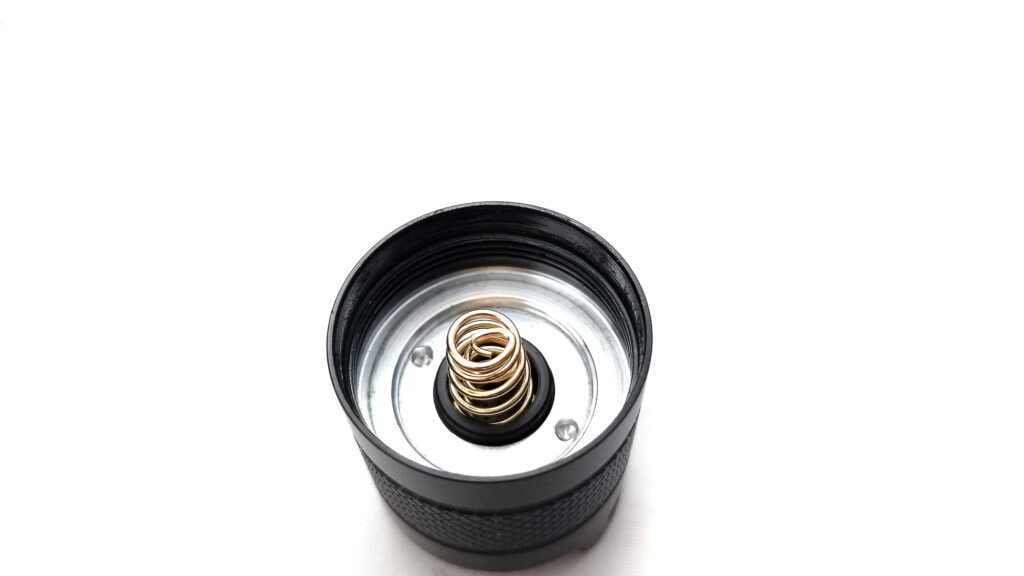
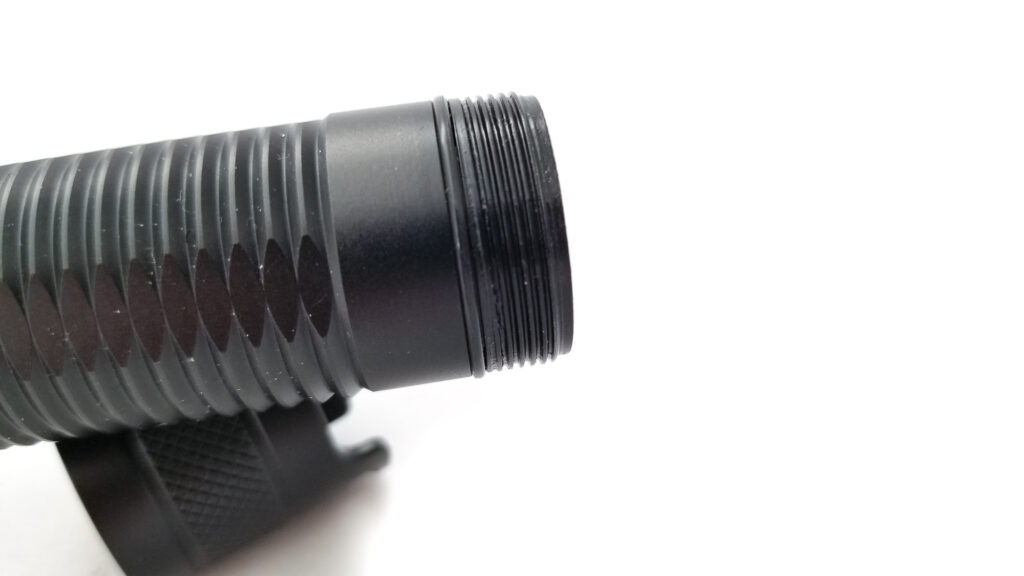
LED, Lens, Bezel, Beam, and Reflector
Nitecore doesn’t hold back the LED particulars of their flashlights, which is nice, and here’s where it gets interesting. The MH40 and successor MH40GTR both featured Cree LEDs; the XM-L2 and XP-L (respectively), but the MH40S goes a different route with a very different LED.
If I hadn’t been following the flashlight scene, I’d never have guessed what the heck this thing was, but I (and keen-eyed observers) will immediately recognize this LED. Nitecore calls it the Luminengin G9, and it goes by the alias ‘Yinding 5050.’ This is a 3 volt 5050-size LED, but it’s a pretty unique LED in that it features a round LES covered by a tiny AR-coated glass lens. The round LES is 1.6 mm in diameter, for a total LES size of around 2 mm2 (roughly the same size as an Osram Boost HX), so it guarantees a very, very nice candela boost. Although Nitecore doesn’t specify, we all know it’s going to be any tint you want…as long as it’s cool white.
That lovely round LED sits at the bottom of a deep smooth reflector, topped with a dual-AR coated mineral glass lens. The bezel is of unknown material, but probably blackened stainless steel, and it’s aggressively crenulated for some strike action if called upon. The lens is set back from the edge of the bezel about 5 mm, so it’s well protected.
The beam is very nice. The hotspot is clean and symmetrical with no irregularities like I see from square die LEDs. It’s also tight and focused with ample spill, and seems tuned more for throw than close-up work, and there’s tons of distance available. The tint was corroborated by the Opple Lightmaster Pro. On Turbo with the light about 4 meters from the sensor, the CCT showed 5624K and an CRI (Ra) of 56.8. At the same distance, Low mode came in at 5024K and CRI (Ra) 56.2, so the tint does drift up at higher outputs. Now, these LEDs are known for having a case of the greens, and it didn’t disappoint because this is the greenest LED I have ever seen. The Low mode duv comes in at 0.0210, and Turbo isn’t much better at DUV 0.0165. Peeking inside the reflector, you can see the lens covering the LES has a very green AR coating to it, so that’s probably accentuating the green a bit. Yep, Kermit the Frog would be right at home with the MH40S.
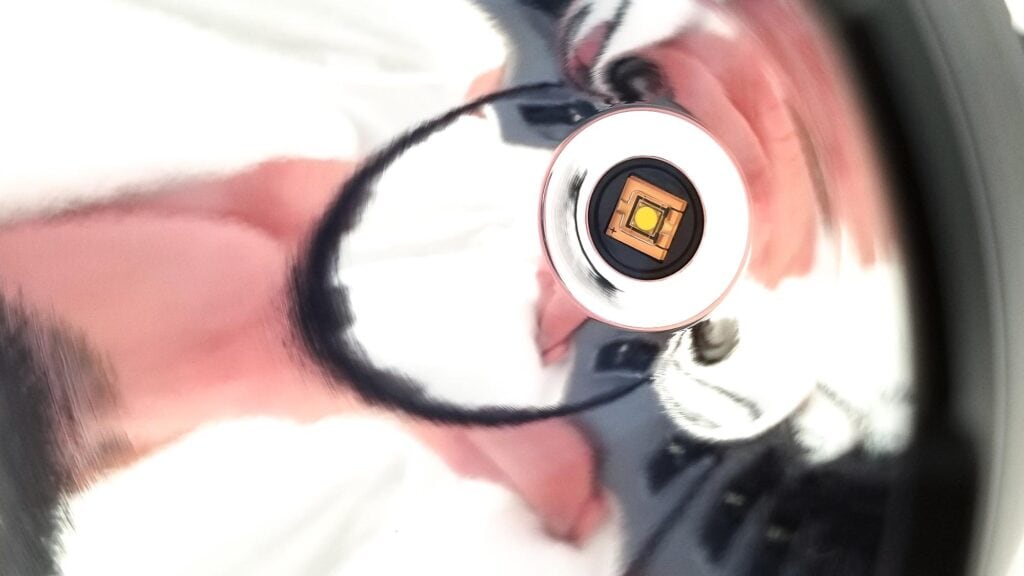
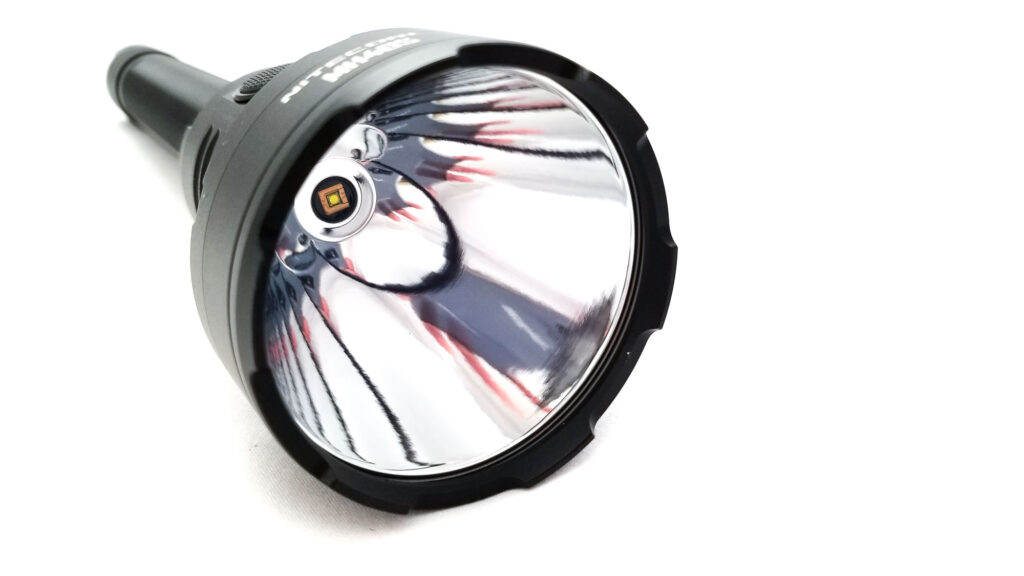
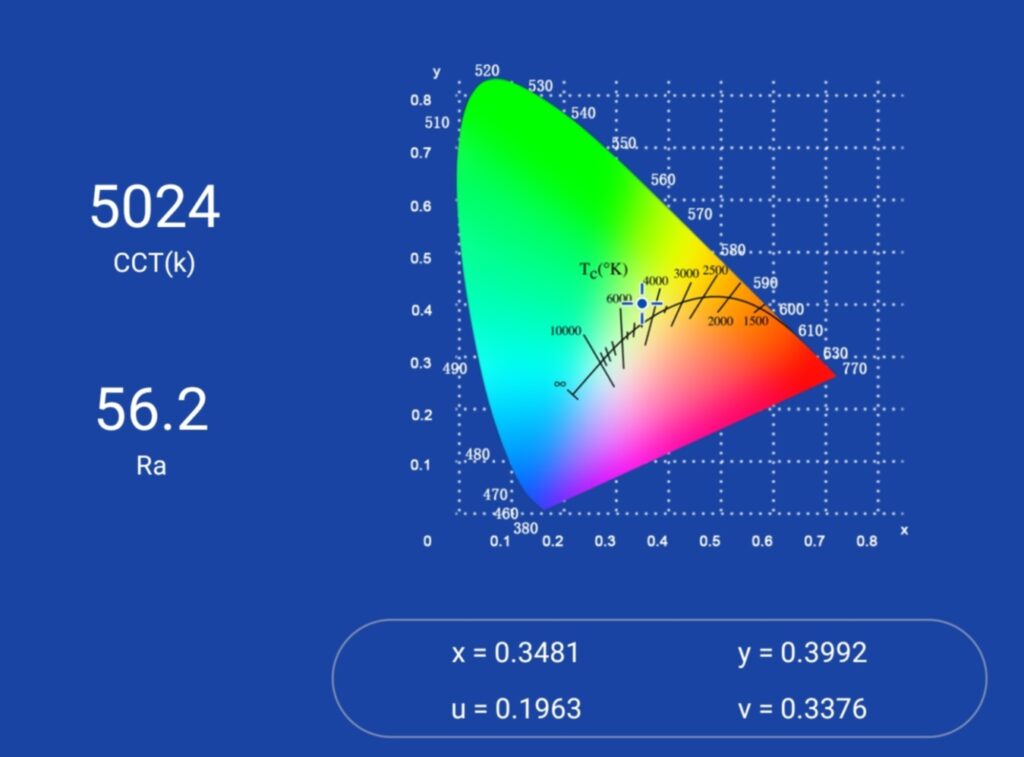
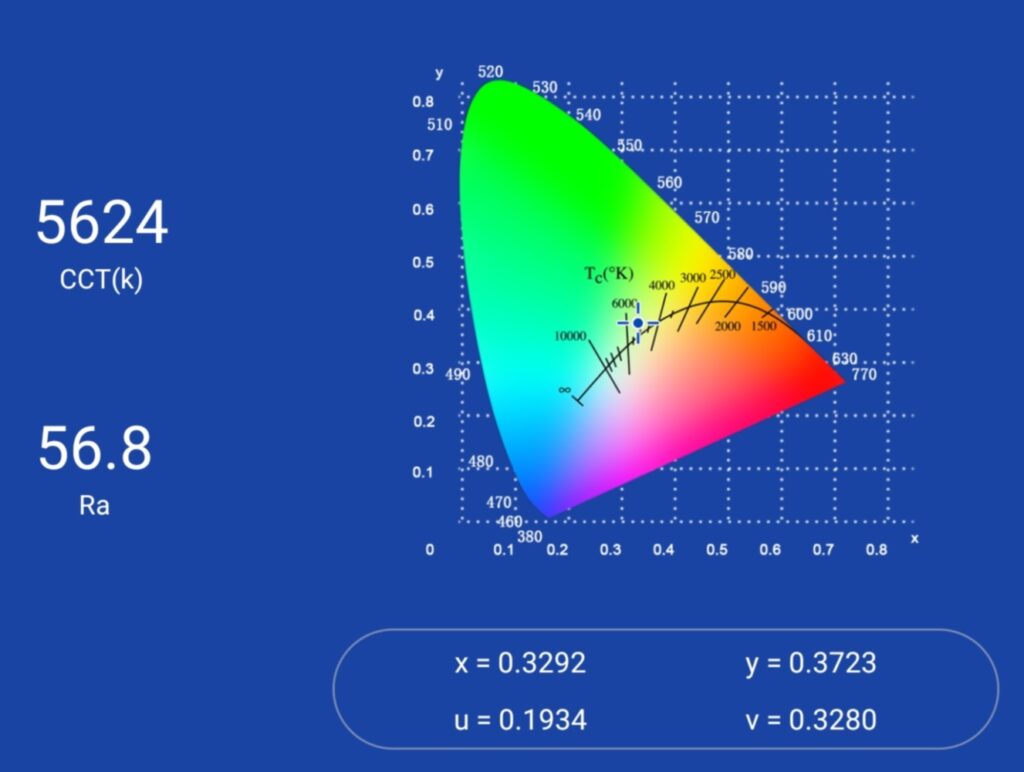
Dimensions and size comparison
Dimensions:
| Dimension | Millimeters | Inches |
|---|---|---|
| Length | 256 | 10.08 |
| Head diameter | 65 | 2.56 |
| Body diameter | 25.8 | 1.02 |
Weight:
| Weight | Grams | Oz. |
|---|---|---|
| Without batteries | 247 | 8.7 |
| With 2x NL2150 batteries | 389 | 13.7 |
Flashlight size comparison with its competition
I compared the MH40S to some similar lights, long and short.
Group 1 left to right: Nitecore MH40S, Lumintop PK21, Wurkkos DL70, Nightwatch
Group 2 left to right LEDs only: Thorfire C8, Nitecore MH40S, Wurkkos DL70
Group 3 (series 21700 flashlights) top to bottom: Nightwatch, Nitecore MH40S, Wurkkos DL70
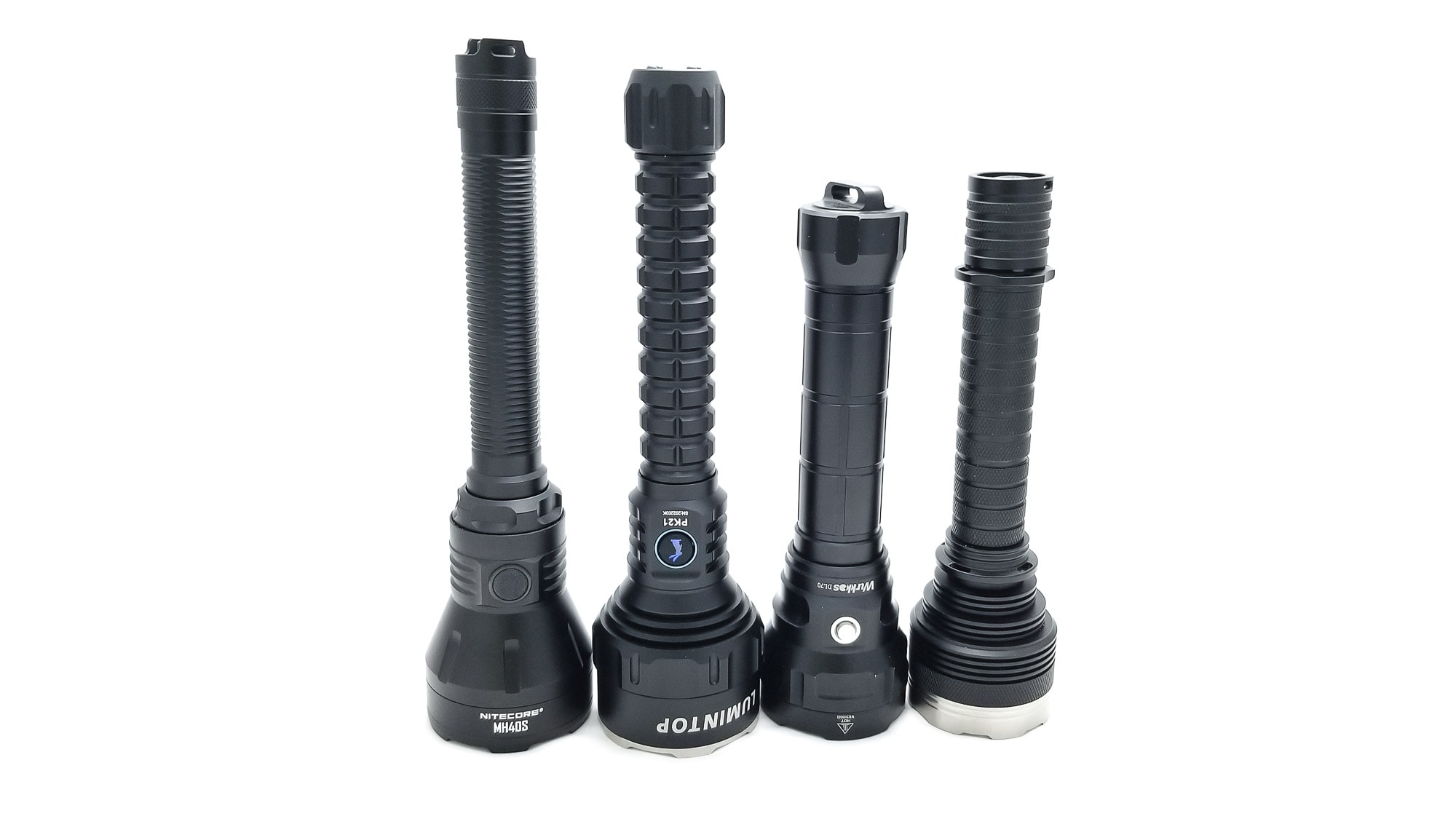
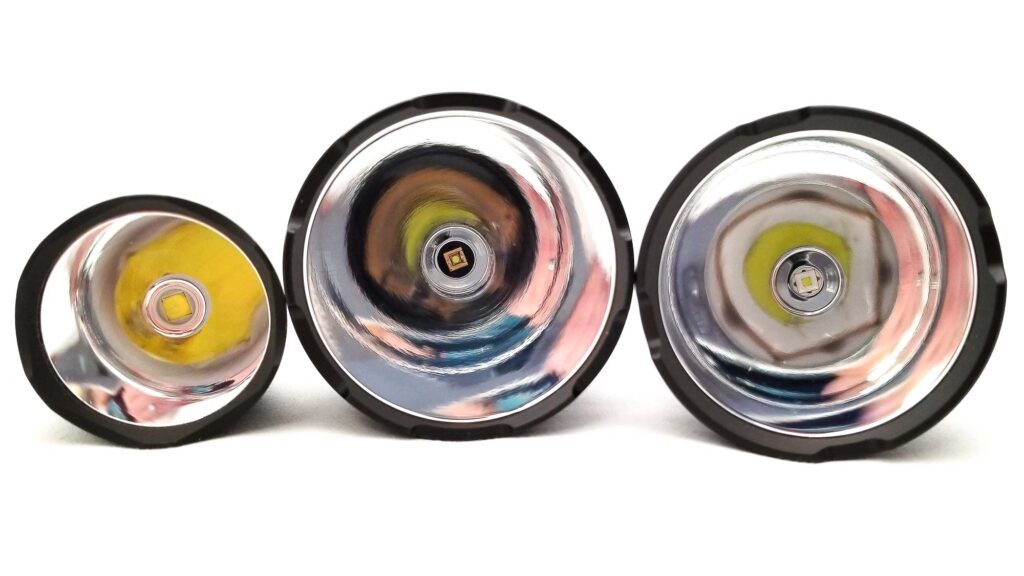
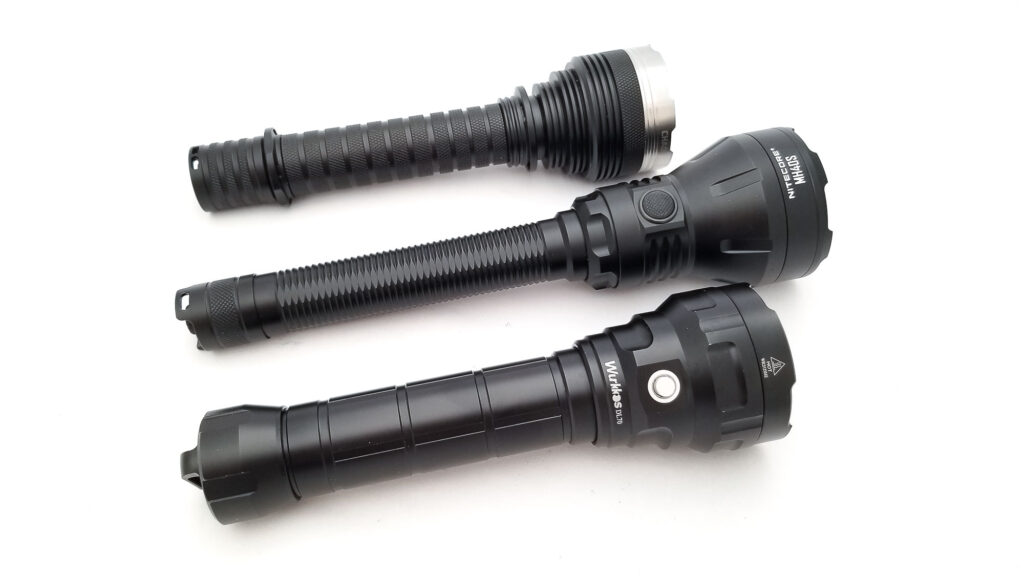
Driver & User Interface:
Since the MH40S uses two 21700s in series, it has to be using a buck driver to step the 8.4 volts down to 3 volts to keep from popping the 3 volt LED. I really like these drivers because they produce laminar output wherein the light output doesn’t change as the battery drains. The brightness stays constant as long as the driver stays in regulation.
The MH40 series lights had some interesting UIs, and I’m glad to see the MH40S has eschewed the prior versions’ twist-for-Turbo weirdness for a more conventional UI and mode switching. The side switch controls the modes and the rear clicky is for on/off and momentary use.
Note that the light cannot be turned on without fully clicking the rear switch as it breaks the current path. The remote switch mirrors the functionality of the main UI, and uses a 2-button configuration for each function.
Available modes: Low, Mid, High, Turbo
Available blinky modes: Strobe, SOS, Beacon
User interface:
From OFF:
- Press and hold side switch: N/A
- Half press rear switch: Momentary on
- Fully click rear switch: Turns on in last mode
- Double click: N/A
From ON:
- Press and hold side switch: Cycles through Strobe-Beacon-SOS
- Half press rear switch:
- Fully click rear switch: Turns off
- Single click side switch: Changes modes Low-Mid-High-Turbo
Remote Switch User Interface:
From OFF:
- Fully press button A: Turns on
From ON:
- Fully press button A: Turns off
- Half press button A: Switches modes Low-Mid-High-Turbo
- Press and hold button B: Momentary Turbo
- Half press and hold button A: Accesses Strobe. Half press again to cycle between Strobe-SOS-Beacon
Mode memory:
- Yes
Shortcuts:
- None
Haptic LVP: Nitecore’s low voltage vibration indicator
- The side switch has aux LEDs that show battery state, but it is on-demand and doesn’t light up during operation (except when pairing the remote). To access the power indicator function: From off, press the tail switch and side switch at the same time and release both buttons at the same time. The aux LEDs will show the battery state: 3 blinks 100% to 50%, 2 blinks 50% to 25%, 3 blinks 25% or less. Once completed, the light will turn on.
- Nitecore added another LVP that’s new to the MH40 series. In very Olight fashion, the MH40S features haptic (vibrating) LVP indication. If the battery is 10% or less, the light will vibrate at 10 second intervals.
Strobe/blinkies
- Strobe, SOS, Beacon accessed by pressing and holding the side switch while the light is on. Release the switch in the desired mode. Click the switch again to return to the regular modes.
Lock-out mode:
- None
PWM
- Not visible
Additional info on the UI:
- This is a simple UI, as it should be for a working light (how many pros want to wade through menus and click, click, click, click, click, clicking all the time?). I like how it’s tailored around the remote switch and it’s similar to other dual switch tactical style lights.
- The fact that Nitecore added haptic LVP is freaking awesome since Olight is the other other company to do that that I know of on the Odin and Warrior series. It’s a foolproof way to tell the operator the battery is going bad, and much less annoying than blinks that interrupt the output.
- There’s no lockout mode, and there doesn’t need to be one since the rear clicky breaks the current path. Although mode memory is a bit taboo on a tactical-use light like this, it does have merits in certain applications. The remote switch is an excellent addition and I like the integration with the dual buttons for regular modes and momentary Turbo. All important stuff for tactical users.
Pairing the Nitecore wireless remote switch
The remote comes paired with the light out of the box, but if it ever becomes unpaired, it’s a simple process to reconnect it: Half press the tail switch while holding the side switch for 5 seconds until the light flashes quickly to indicate the pairing mode is active. While the light is blinking, press the A and B buttons simultaneously until the blinking stops and the light stays on.
Batteries & Charging
The Nitecore MH40S carries forward the dual battery configuration of the original and GTR model, but instead of 18650s, the S model adopts 21700 size li-ions. This is great because it roughly doubles the capacity of the GTR model. These batteries are arranged in series, and Nitecore includes their excellent NL2150 protected button top 5000 mAh 21700s. The good news is that these aren’t proprietary, so you can use any button top 21700s that fit, but I see no need to do that.
Also new is the charging interface. Gone is the wonky, good-for-wireless-telephones micro barrel connector and in with USB type C. This is a good move since cables and power supplies are everywhere, but you don’t need one because Nitecore throws in a QC 3.0 charger with the MH40S. It’s rated for 18 watts, a good thing since at standard charge speeds it would take a long time to charge two 5 Ah batteries. According to Nitecore, it should charge the 10 Ah worth of batteries in about 3 hours (yep, I’ll test that). My Ruideng AT35 USB tester shows 12.1 volts at about 1.5 amps, or right around 18 watts (as promised) with depleted batteries. Note that the rear switch must be fully clicked on in order for the onboard charging to work.
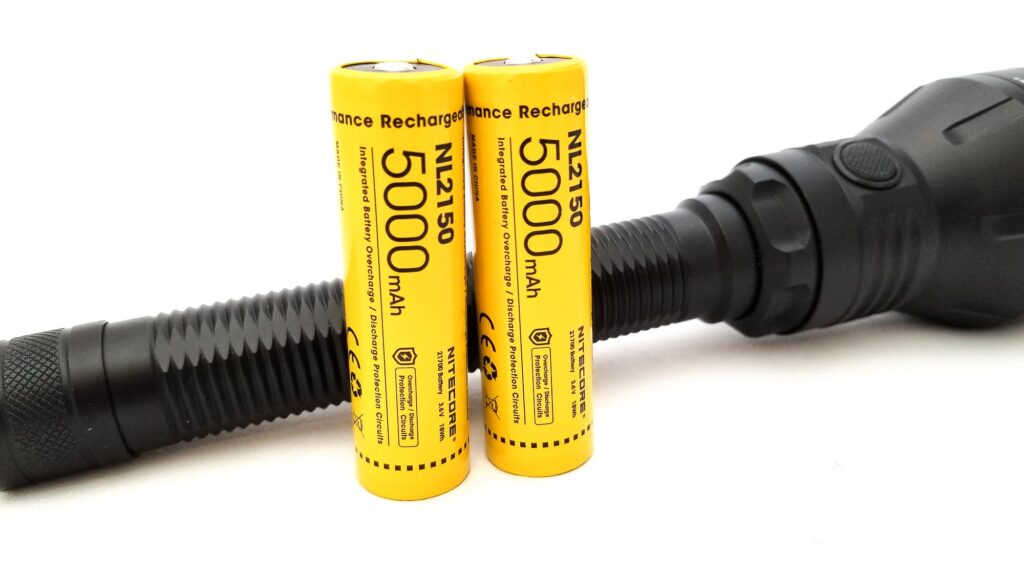
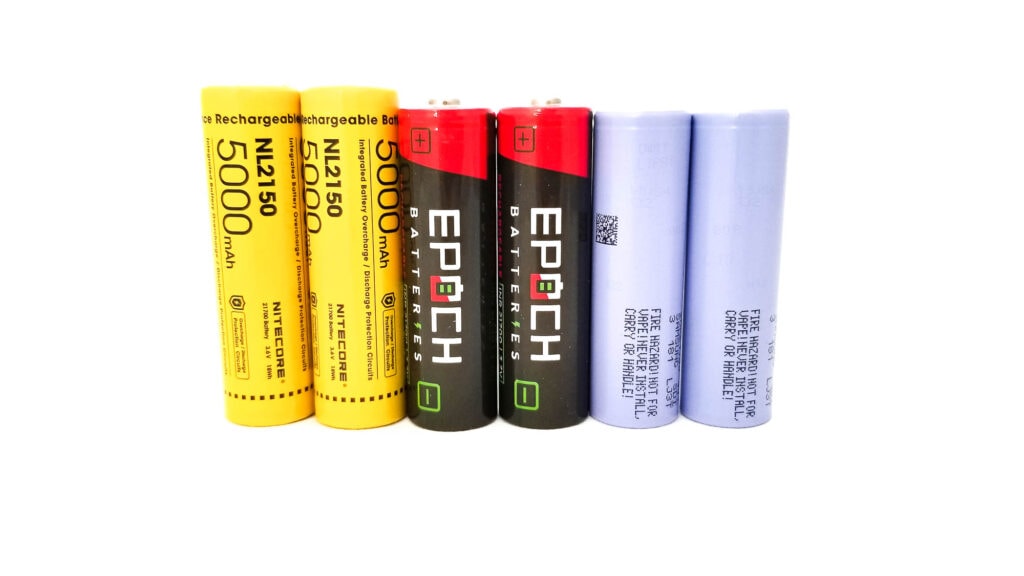
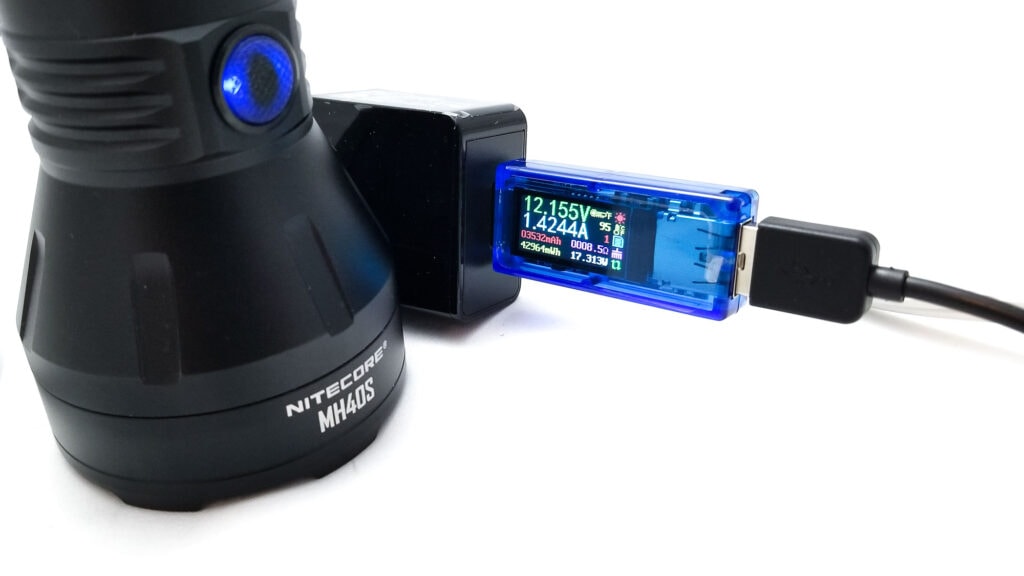
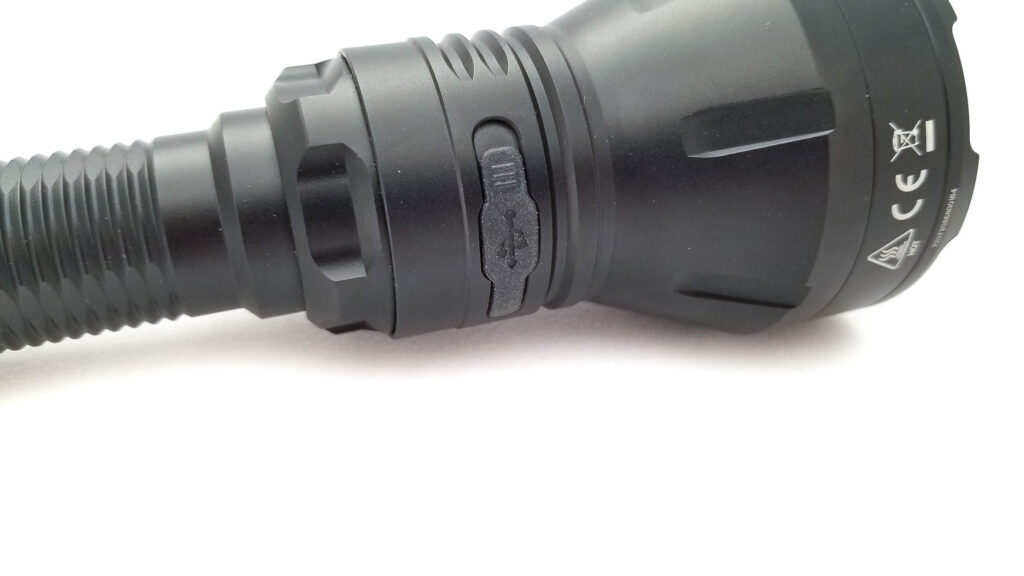
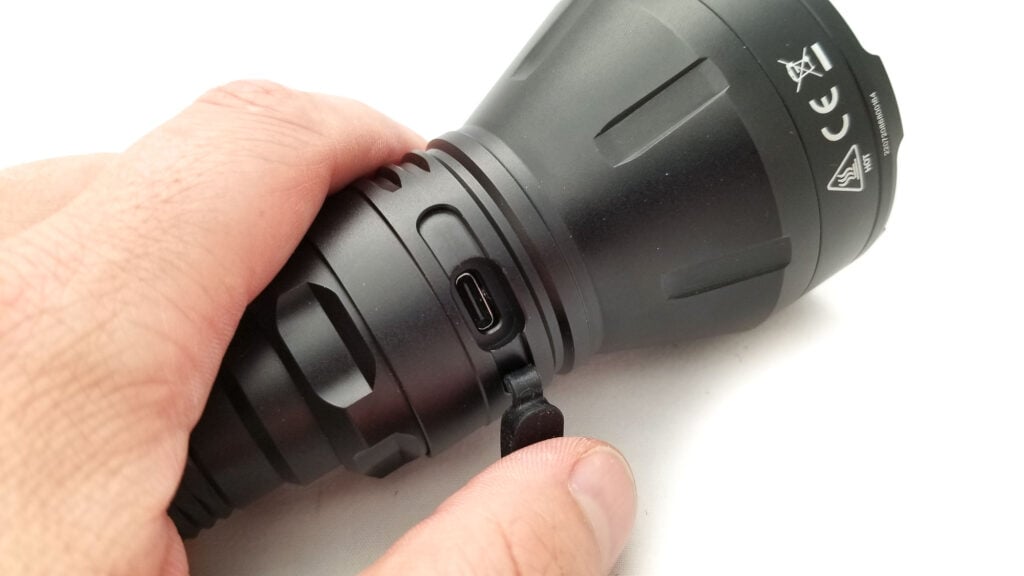
Performance test
Lumen measurements
Lumens are measured using my home made 50 cm integrating sphere, and I use a Digi-Sense 20250-00 datalogging luxmeter. The sphere has been calibrated using many lights of known output and is accurate within 10% of actual output. All measurements taken at 30 seconds using the fully charged Nitecore NL2150 5000 mAh batteries. Amps were measured with my Thsinde 18B+ multimeter with 14 gauge wires in the meter and higher currents with my FY219 clamp meter and a loop of 12 gauge wire.
| Mode | Amps at start | Specs | turn on | 30 sec | 10 minutes |
|---|---|---|---|---|---|
| Low | 80 mA | 18 | 21 lm | 21 lm | – |
| Mid | 190 mA | 150 | 167 lm | 167 lm | – |
| High | 630 mA | 500 | 560 lm | 560 lm | 546 lm |
| Turbo | 3.76 A | 1500 | 1638 lm | 1498 lm | 840 lm |
Take the current draw figures with a grain of salt because the MH04S has a buck driver and these numbers are the battery input voltage, not the actual current to the LED, which may be higher than listed.
Parasitic drain:
- 0.58 mA
Battery Life: Runtime graphs
Runtimes were measured in my home made 50 cm integrating sphere. I use a Digi-Sense 20250-00 datalogging luxmeter. The sphere has been calibrated with many lights of known output and is within 10% of actual output. I used the fully charged Nitecore NL2150 5000 mAh batteries for each test. I tested High and Turbo modes.
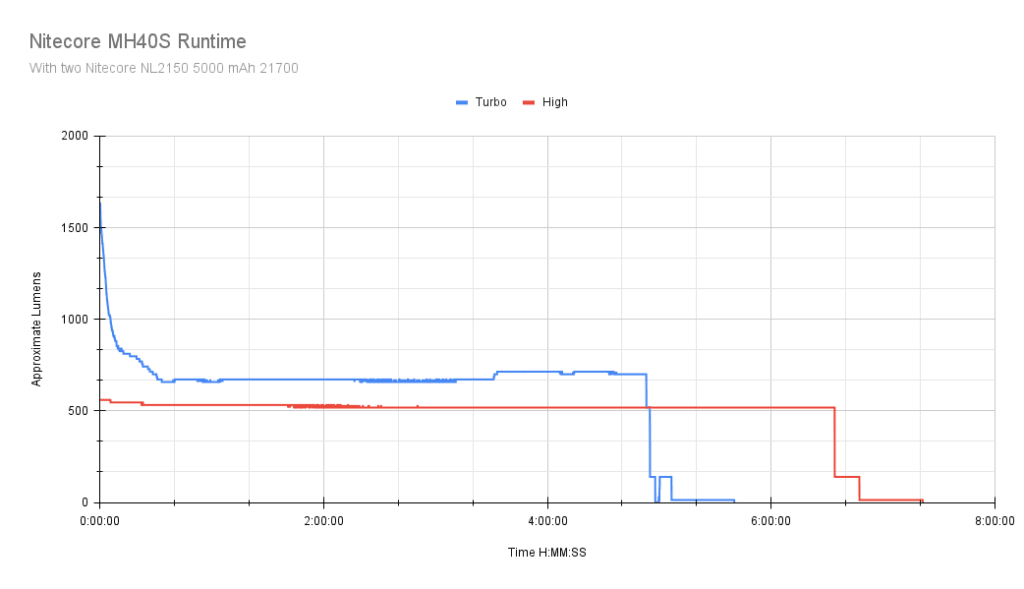
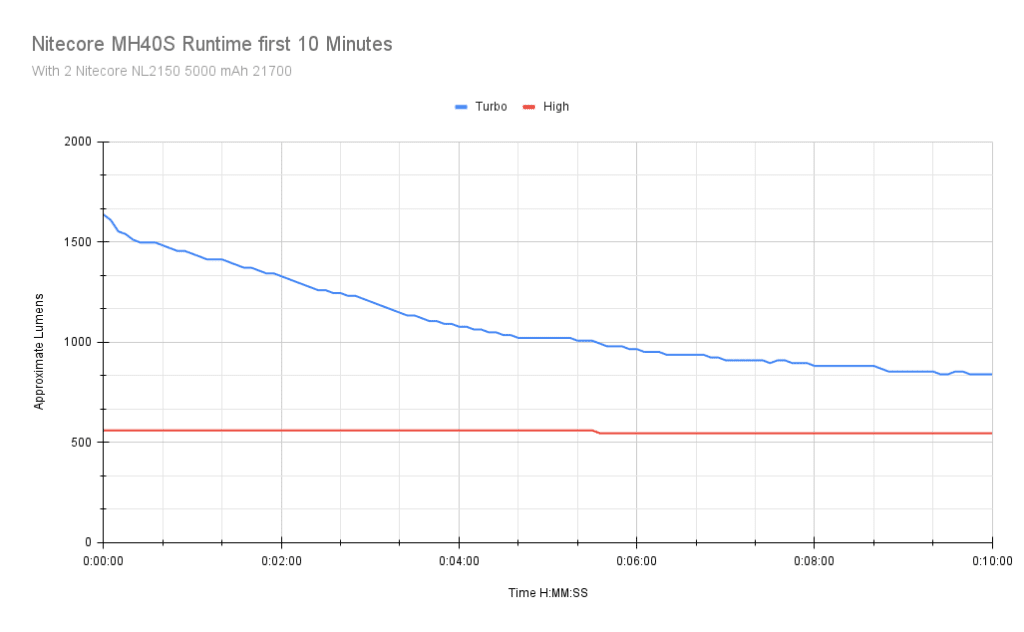
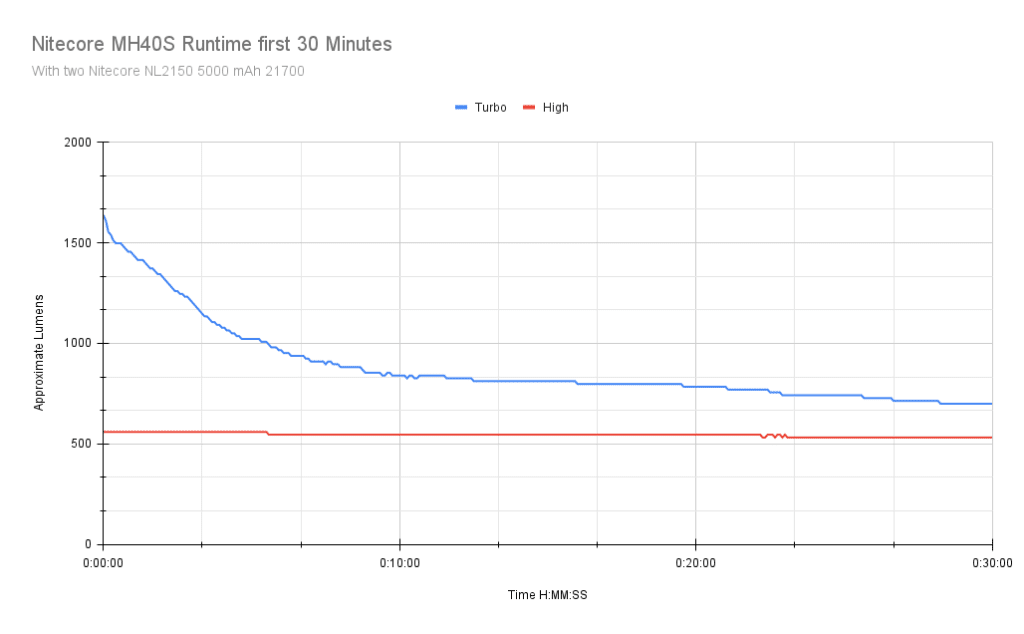
| Mode | Specified | Measured runtime (ANSI) | Time till shut off |
|---|---|---|---|
| Low | 105h | – | – |
| Mid | 25h | – | – |
| High | 7h 15m | 6h 47min | 7h 21min |
| Turbo* | 3h 15m | 4h 55min | 5h 40min |
No drama on the runtimes. I’m a bit over Nitecore’s specs for ANSI. The light was still usable after these tests, although on low output only. The haptic LVP works great, with the vibrations starting about 25 minutes before shutdown, and continuing after the output drops below 10%. The batteries were discharged to between 3.14 and 3.1 volts after the tests, so they will last a long time. Nitecore says the Medium mode runs for 25 hours. I believe it! The light was operable after the tests at low outputs. Turbo and higher modes were accessible, but had very short runtimes until stepping down.
ANSI FL1 standards: The runtime is measured until the light drops to 10% of its initial output (30 seconds after turning on). This does not mean that the flashlight is not usable anymore. The last column shows how long the light actually works till it shuts off. If there is a + symbol, it means that the test was stopped at that particular point, but the light was actually still running. This happens on certain occasions, with certain drivers, firmware, or batteries.
Throw numbers: Peak beam intensity
Throw was measured outdoors at 10 meters using the Uni-T UT383S luxmeter. Measurements taken at 30 seconds. I used the fully charged Nitecore NL2150 5000 mAh batteries for the testing.
| Mode | Specs | Candela measured | Meters | Yards |
|---|---|---|---|---|
| Low | 5800 cd | 9800 | 198 | 217 |
| Mid | 51,000 cd | 71,800 | 536 | 586 |
| High | 186,000 cd | 284,900 | 1068 | 1167 |
| Turbo | 570,000 cd | 737,600 cd | 1718 | 1878 |
At 10 meters, I’m coming in on the high side, and that’s fine with me. There’s lots of throw, and decent spill too.
Extra info: Peak beam distance according to ANSI FL1 standards: The calculated value of distance in meters at which the flashlight produces a light intensity of 0.25 lux. (0.25 lux is about the brightness of a full moon shining on an object).
Beamshots
I compared the MH40S against some other long-range lights.
- Acebeam L19
- Acebeam L19 2.0
- Acebeam L18
- Convoy L21B
- Thrunite Catapult Pro
- Speras T3R
- Lumintop PK21
All of these lights throw 1000 m or more.
The tower is 950 meters away. Photos taken with my Samsung Note 8 on a tripod with the shutter at 0.5s, ISO 400 and the WB at 5000K. The G9 LED is going up against the Luminus SFT-40-W, Osram Boost HX, and W2 CULPM1.TG. The ringer is the Luminus SBT90.2, and the PK21 is just glad to be in the group. Overall, pretty impressive output and throw out of the MH40S.
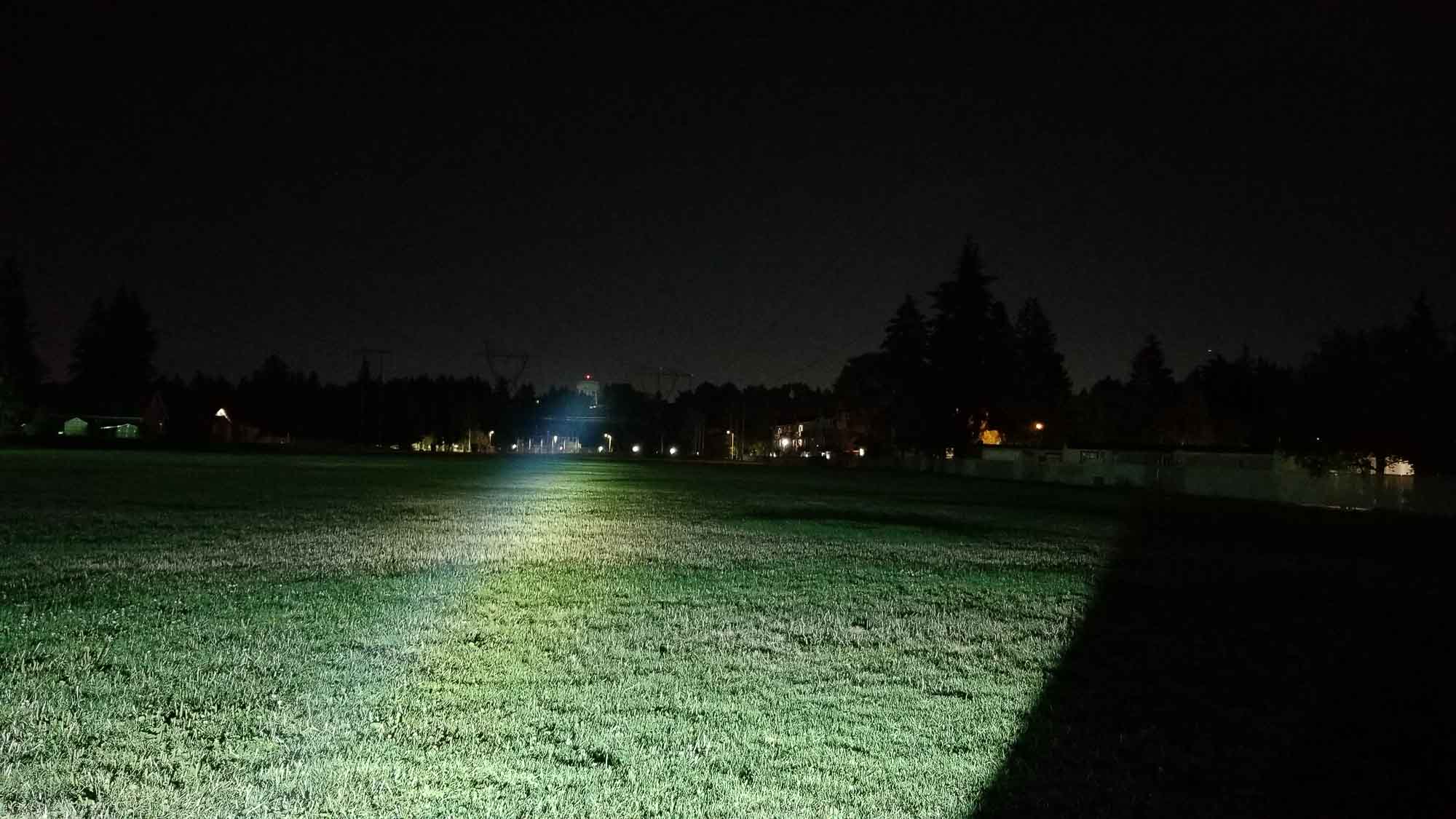
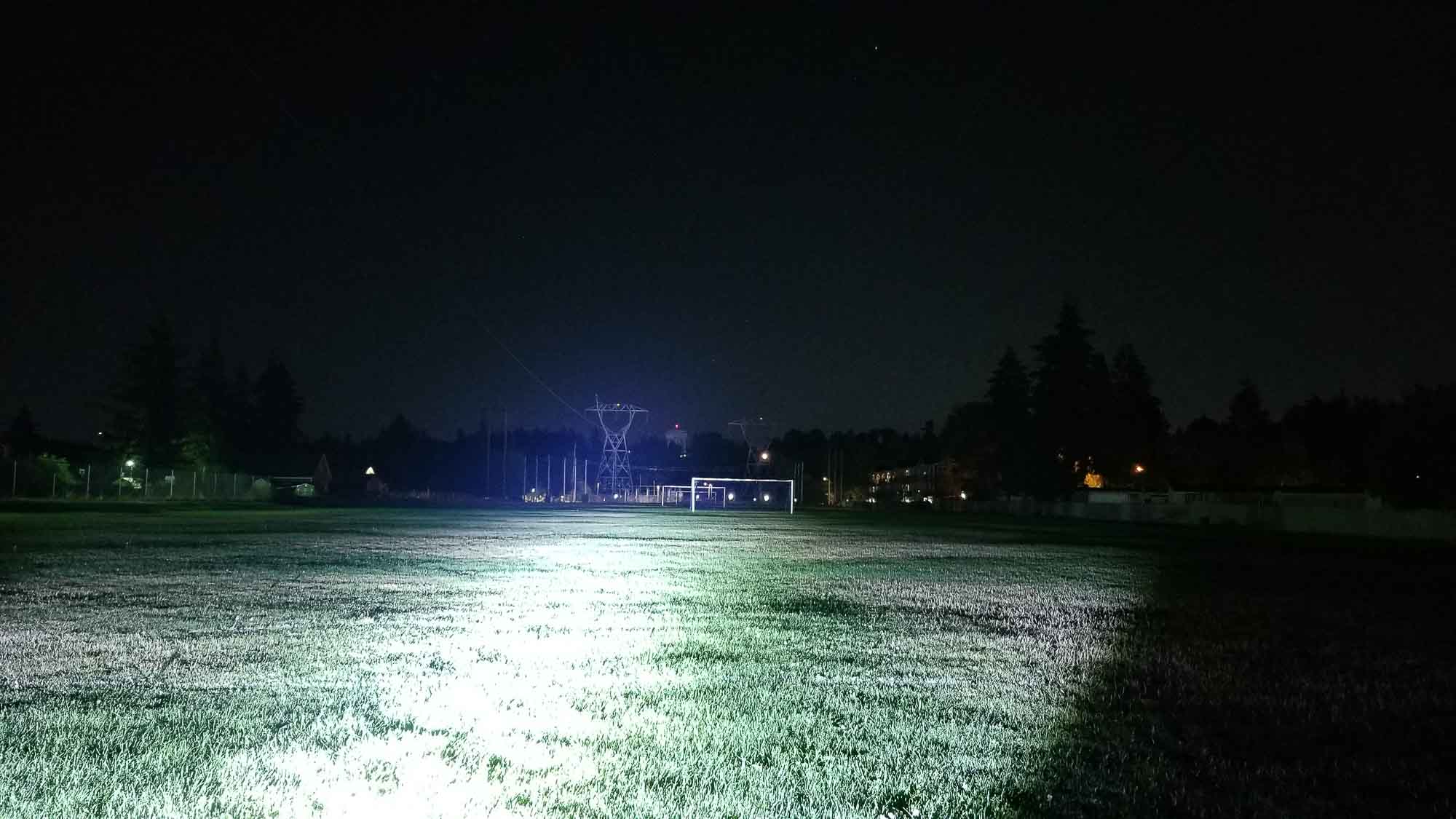
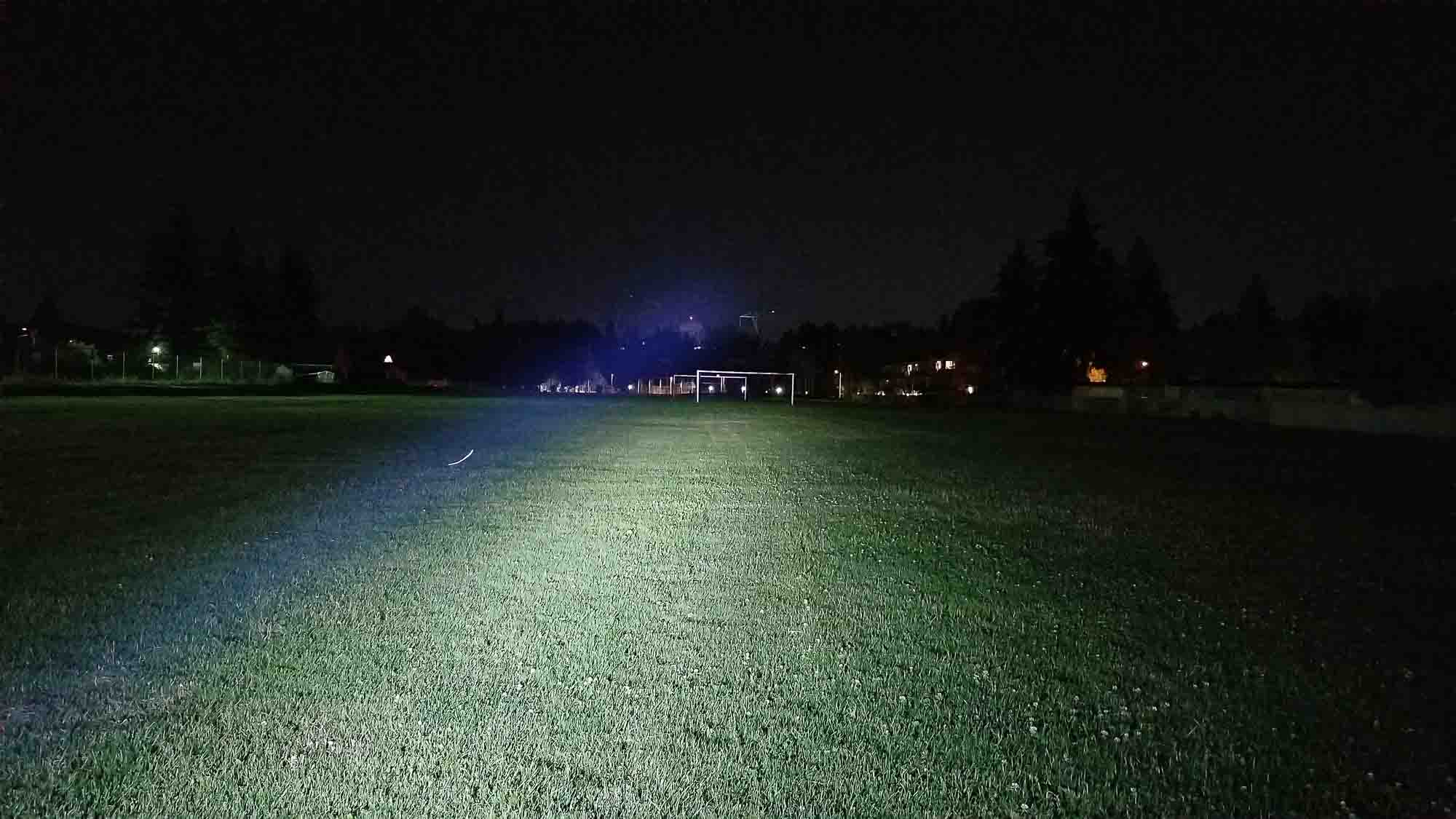
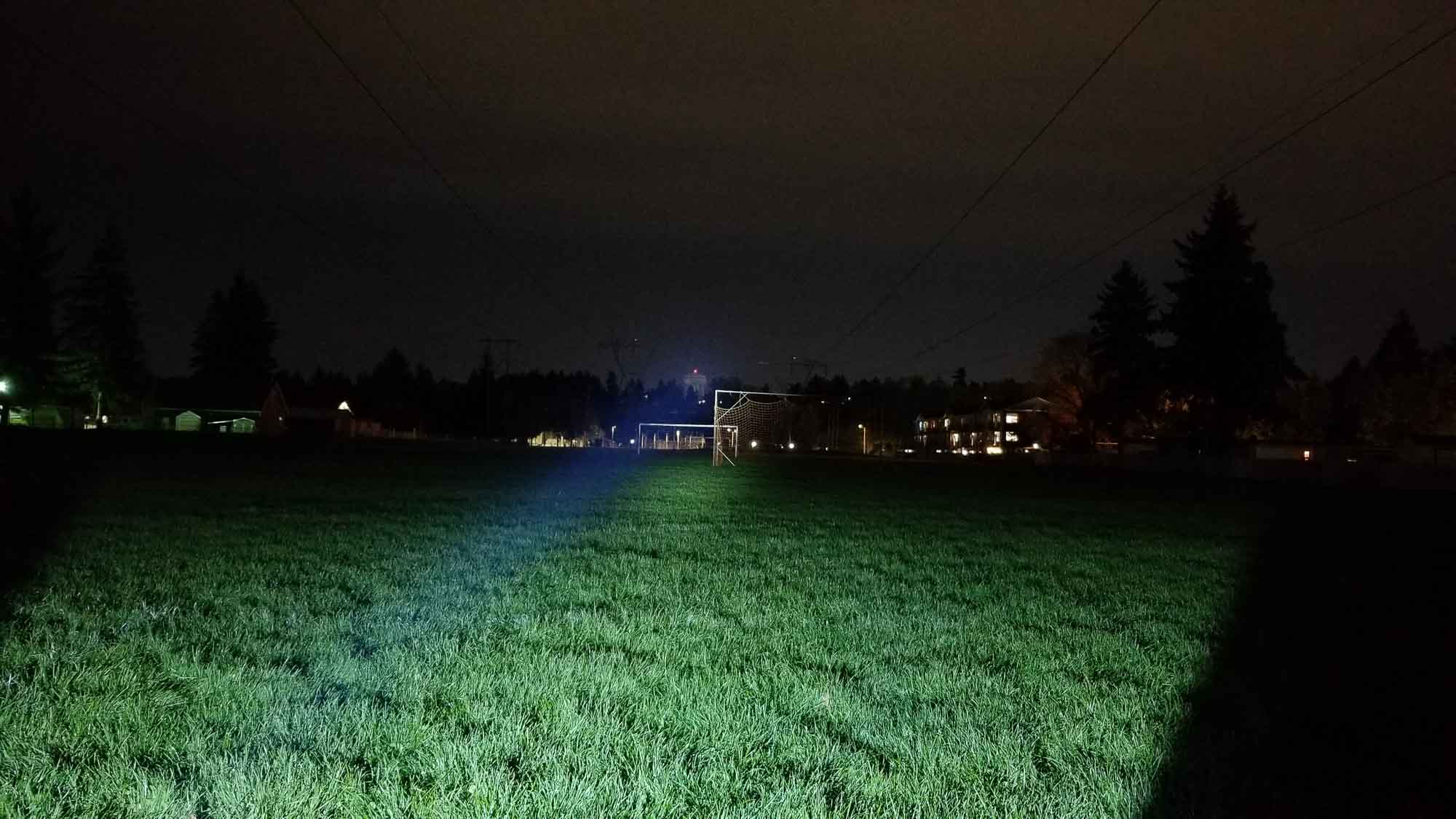
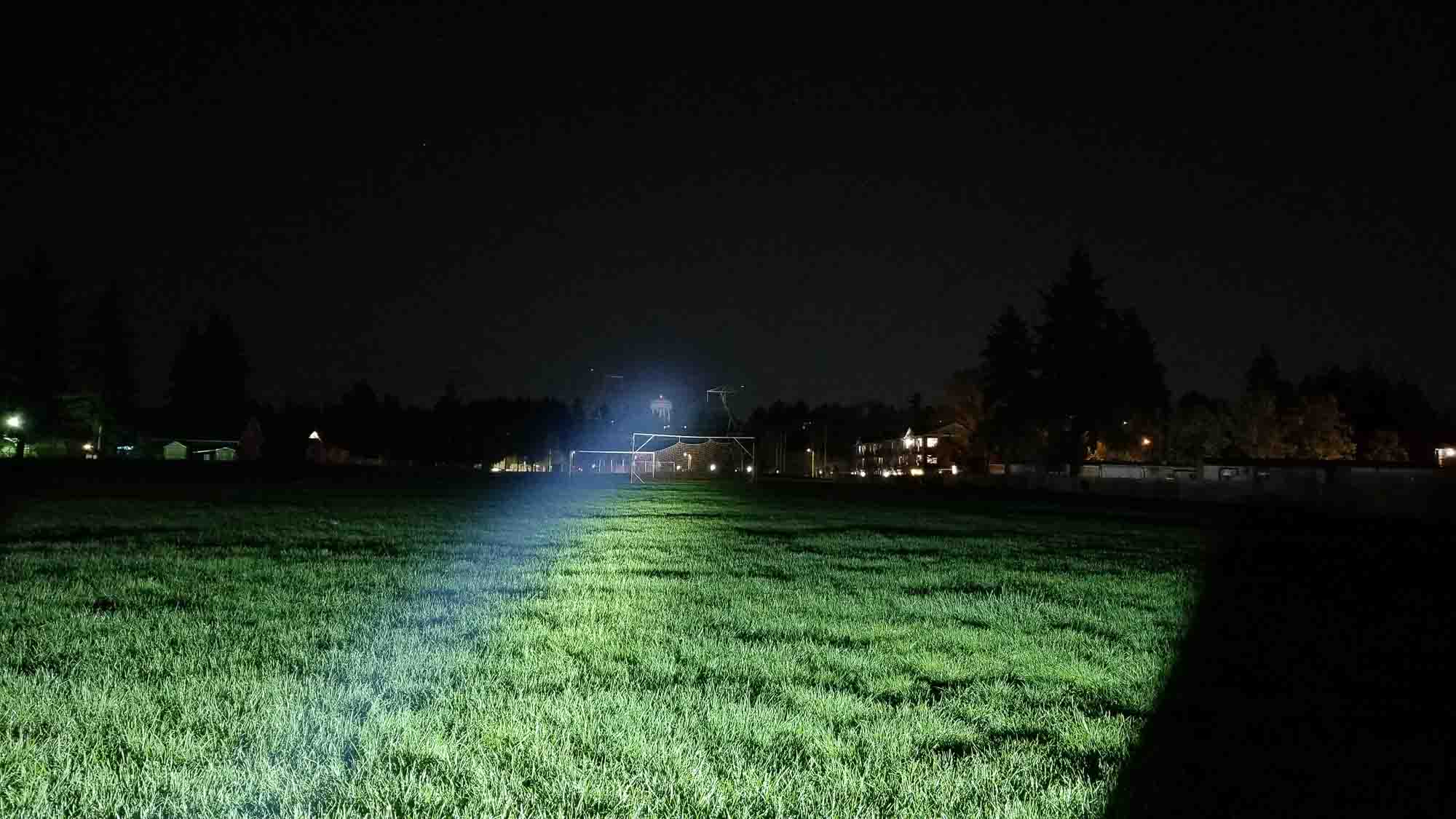
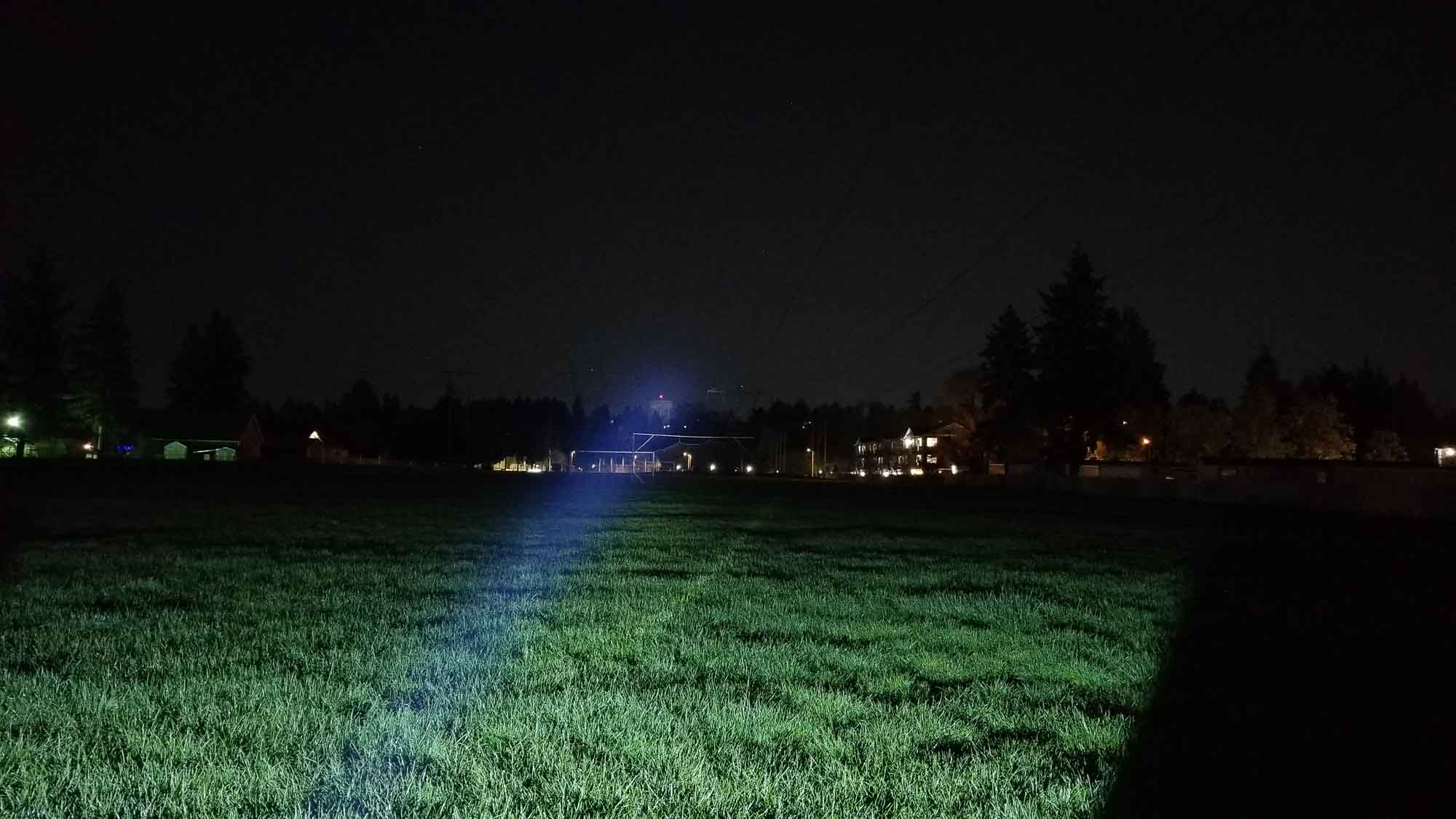
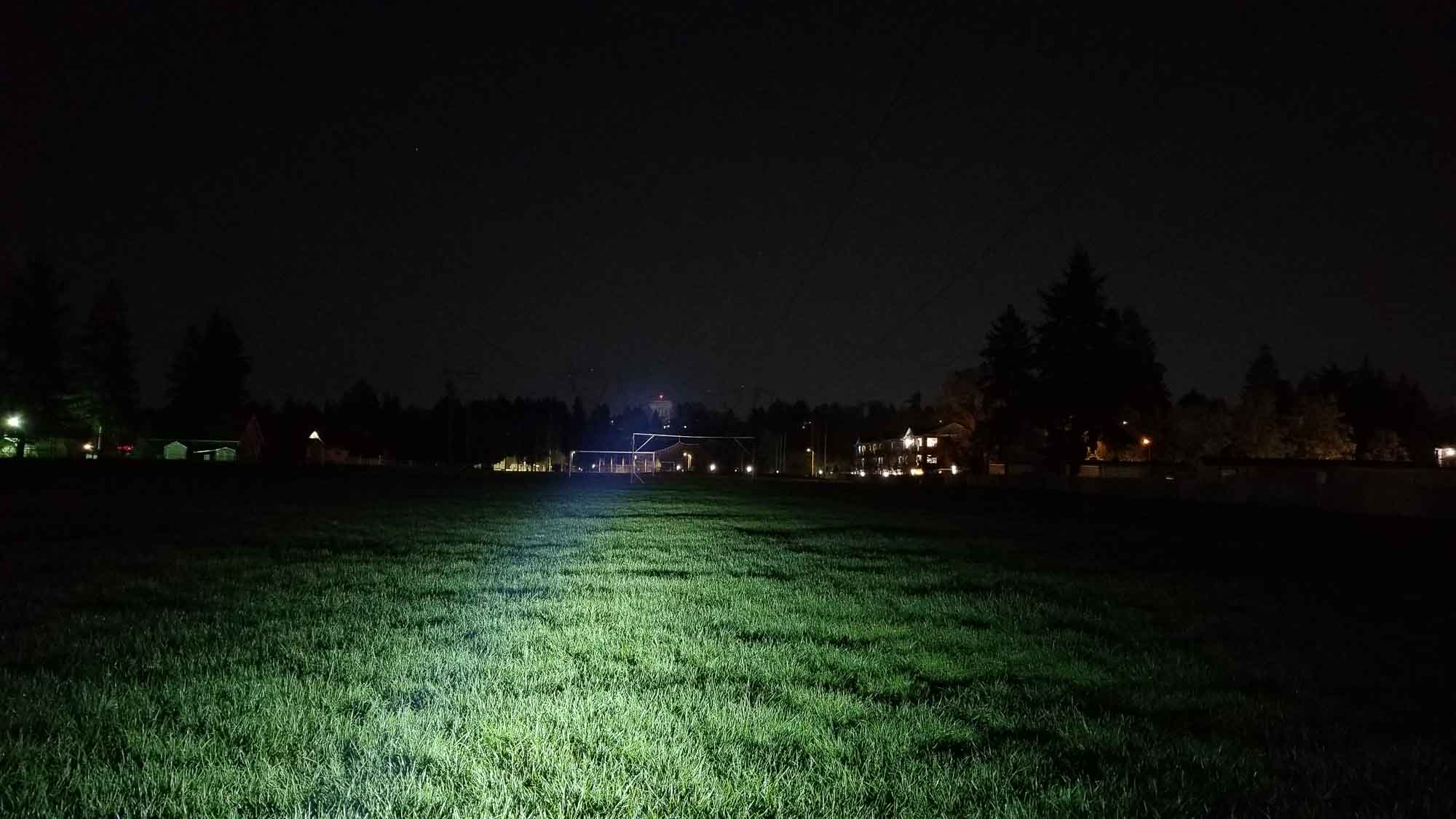
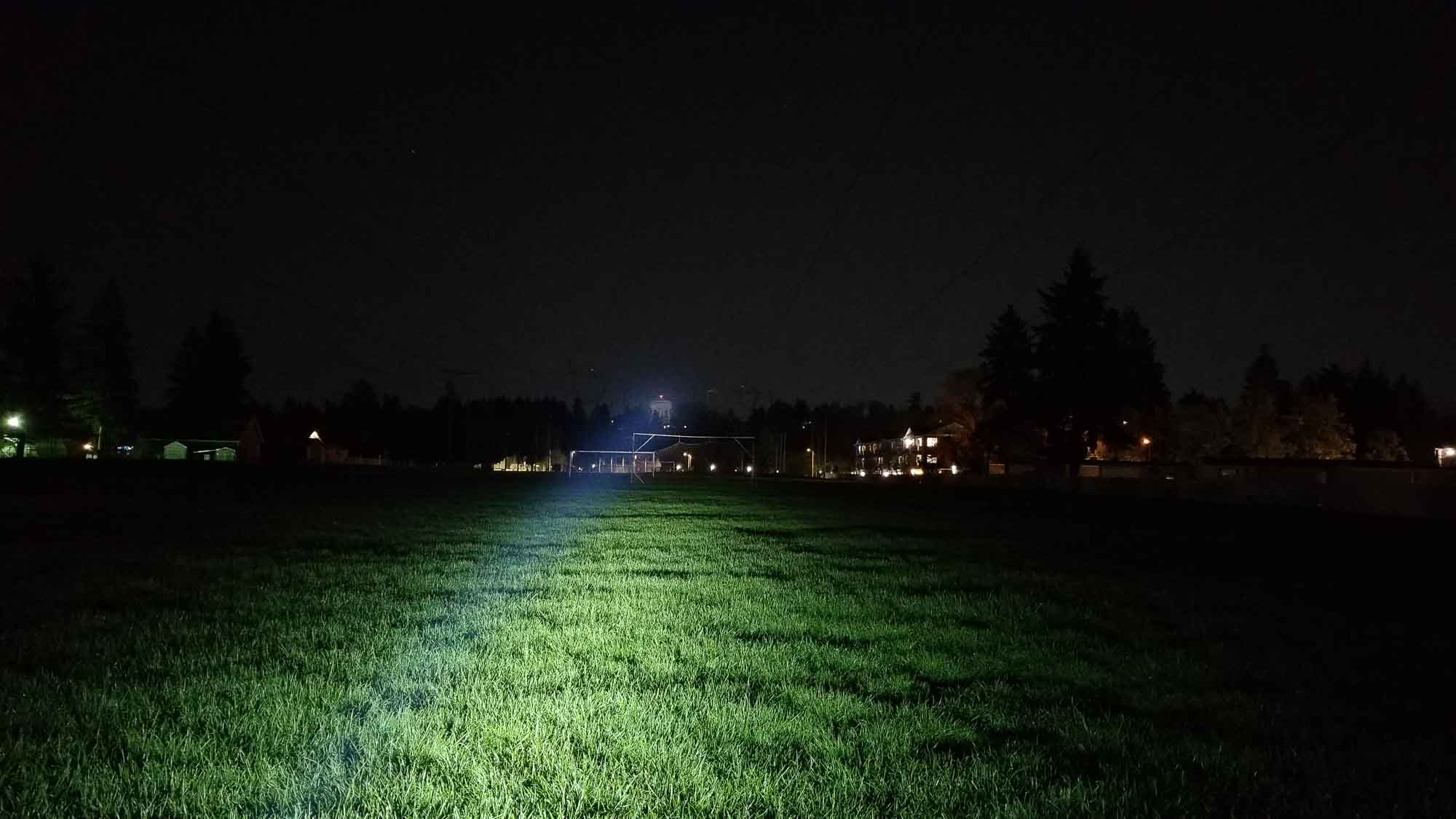
Disclaimer: This flashlight was sent to me for review at no cost by Nitecore. I have not been paid to review, nor have I been holding back on problems or defects.
Final Verdict
Pros
- Great build quality, fit and finish
- Full complement of accessories
- Wireless remote works great
- Lots of throw
- Super simple UI
- Long, regulated runtimes
- Met or beat factory specs
- Haptic LVP!
Cons
- Greeennnnnn tint
- Wish it came with a long rifle mount
- Side switch can’t control modes without the tail switch being clicked on
Explanation on star ratings:
1: Avoid: a match would be a better choice – 2: Poor: significant defect or issues; almost unusable – 3: Average: some defects or issues; but still usable 4: Good: recommended (minor issues) – 5: Great: highly recommended

4.5 stars: ★★★★⋆
After reading about Nitecore lights here on 1Lumen and on other review sites, I was able to ascertain a few things about the brand: They’re more tactical than tacti-cool, they cater to a specific audience, and they make good lights. After my time with the MH40S, I can confidently affirm all of the above.
The MH40S really embodies the best of the best flashlight tech right now, and it’s a fantastic upgrade over the older MH40 GTR. With the wireless remotes, high intensity round-LES emitter, QC3 USB type C charging, haptic LVP, and dual 21700 batteries, there’s lots of great tech.
After the A1, I never thought I’d see a wireless remote on a small flashlight, but here we are, and it works great. I think the MH40S would be right at home on a long gun for nighttime hunting (where legal), but even if you’ll never mount your MH40S to a long gun, the wireless remote is a nice feature for hands-free operation. The MH40S just works great.
I love the haptic LVP, the driver is well regulated, it handles nicely for a long light, and it’s fully kitted out and ready to go out of the box. Although the G9 LED really helps the throw, the green tint is pretty bad, to the point I thought a leprechaun would jump out and ask me if I wanted some Lucky Charms.
Seriously, I don’t generally camp on tint anomalies, but it’s so green, it’s distracting. Also, I think the side switch should be able to control mode switching without having to activate the tail switch, but I get it since that would require a special tailcap and/or a signal tube (a long one) to work. Why Nitecore didn’t just include a long gun mount in the box is kind of odd since that’s all it needs to be truly firearm-ready. Overall, Nitecore nailed it with this latest-and-greatest MH40 series light. 4.5 stars.
Nitecore MH40S discount code
Get 15% off by using discount code 15OFF on orders above $75. Below $75, use our unique coupon code 1Lumen to get 10% off.
1lumen selects and reviews products personally. We may earn affiliate commissions through our links, which help support our testing.